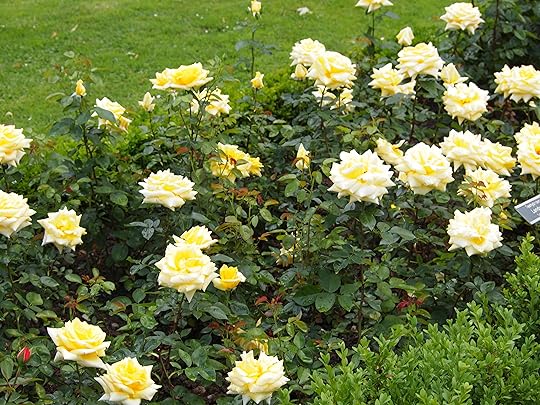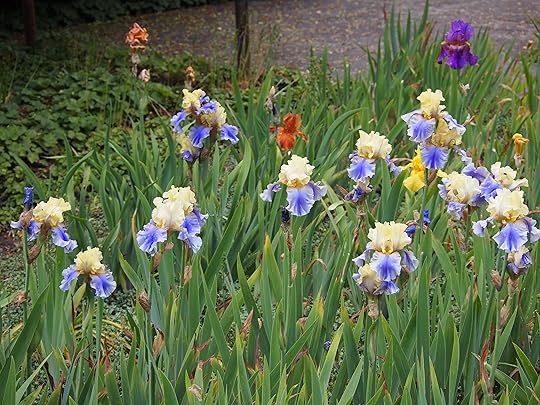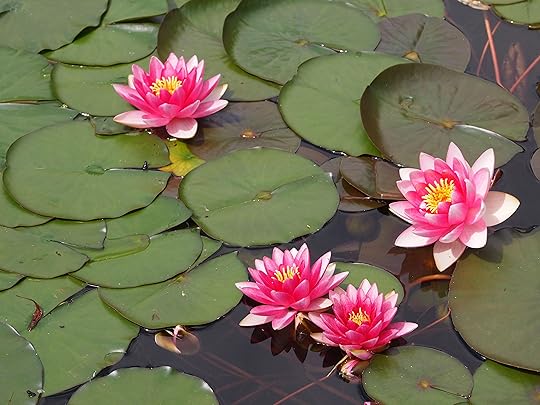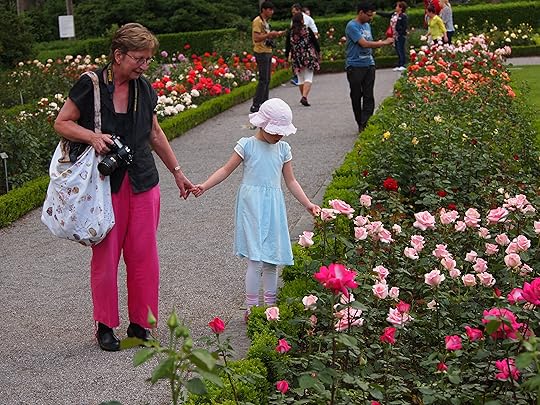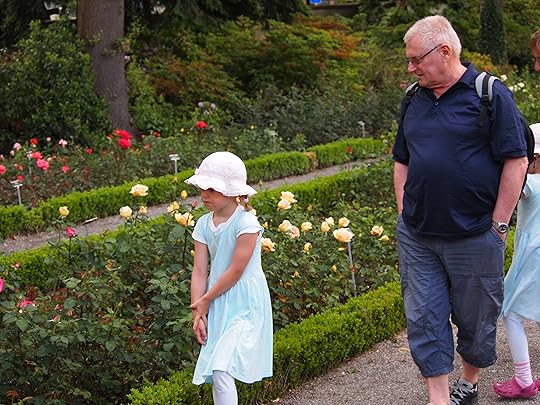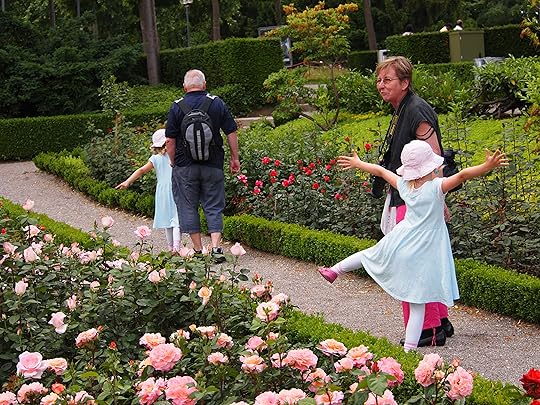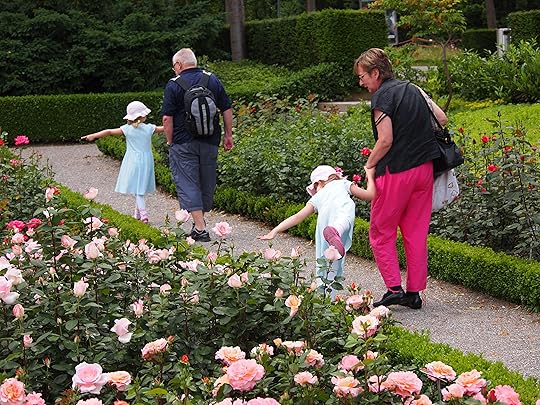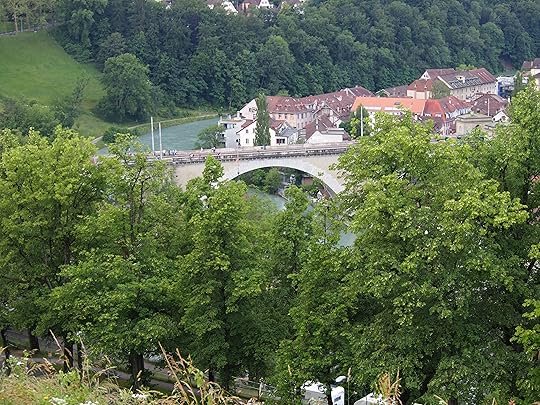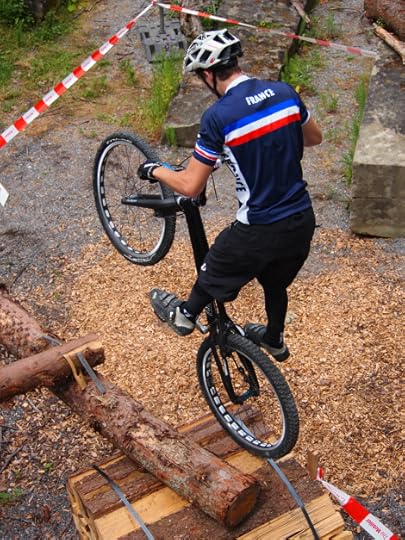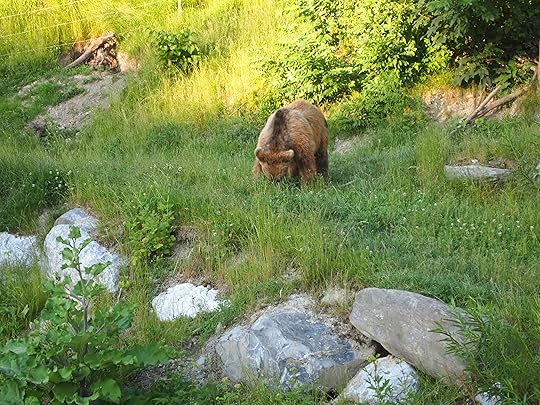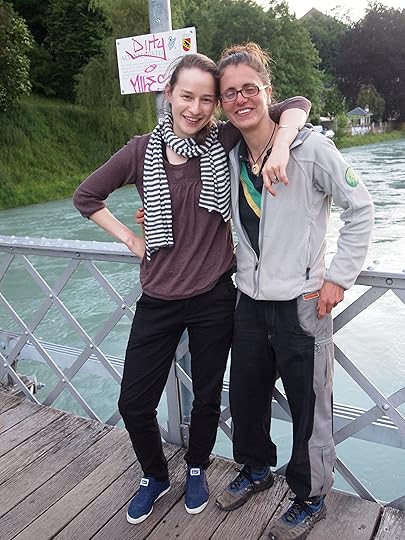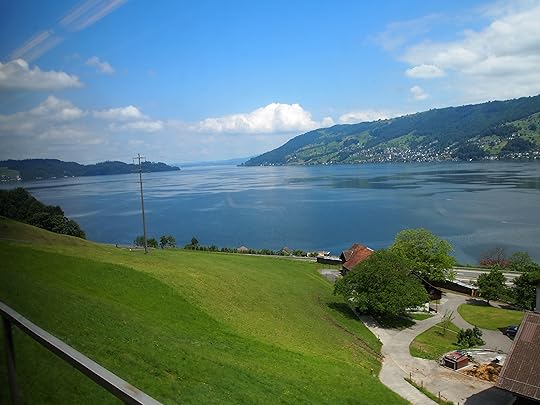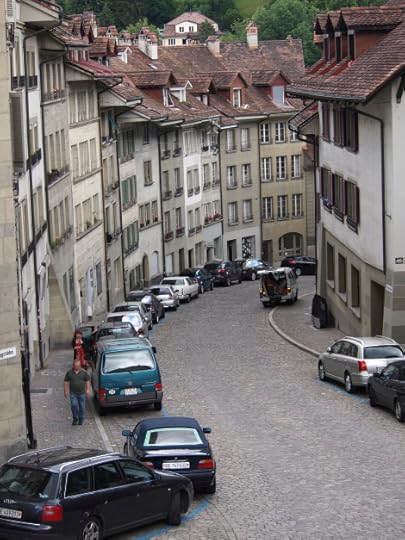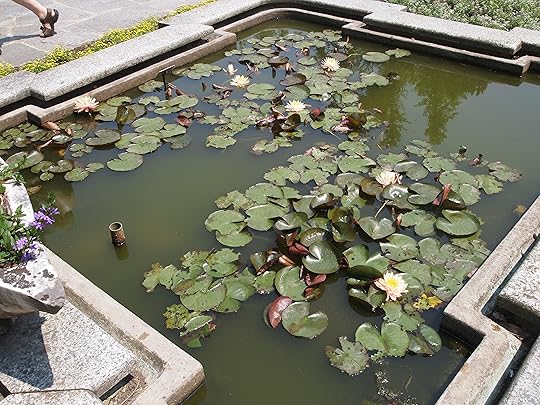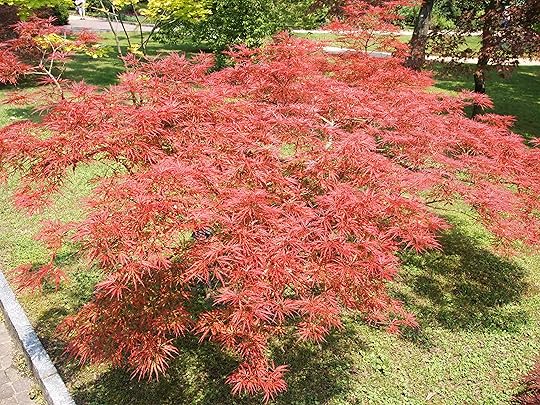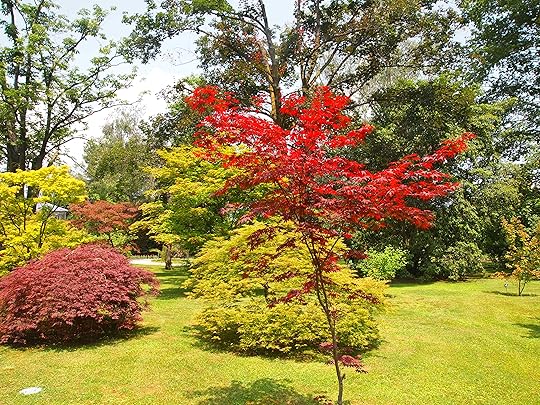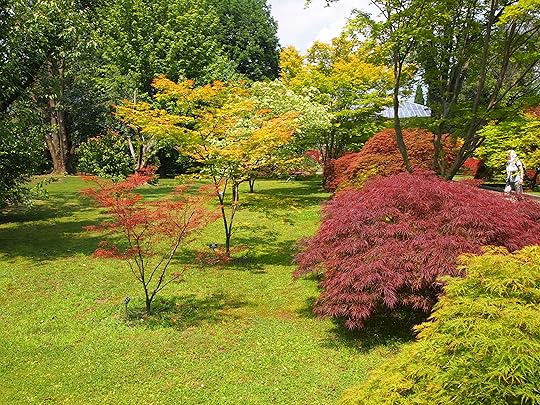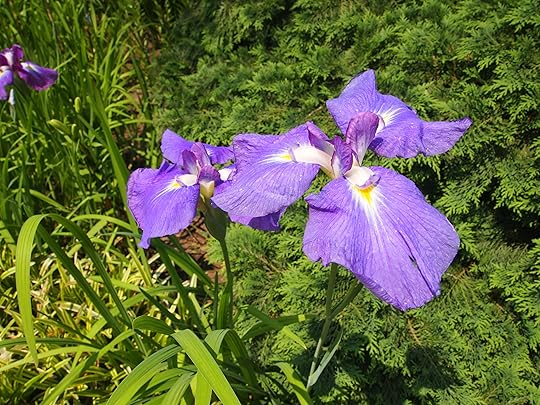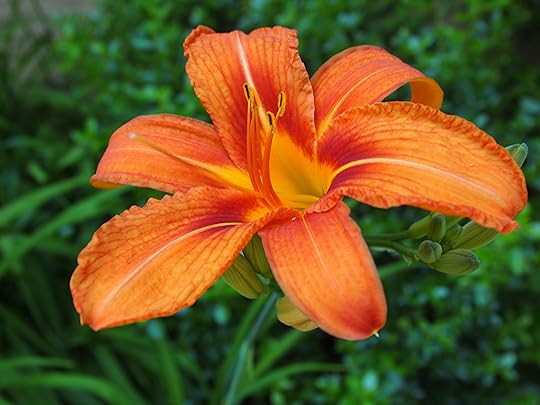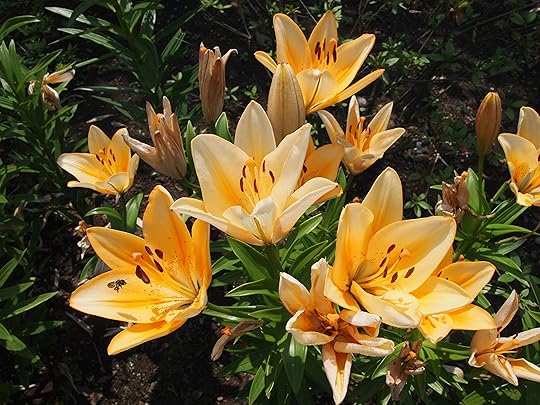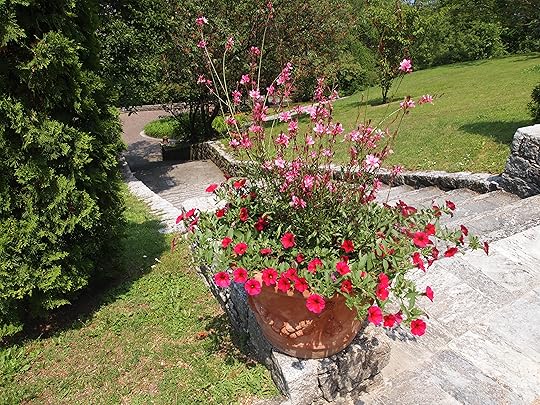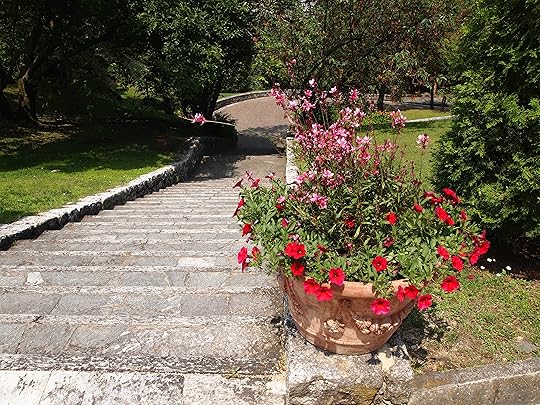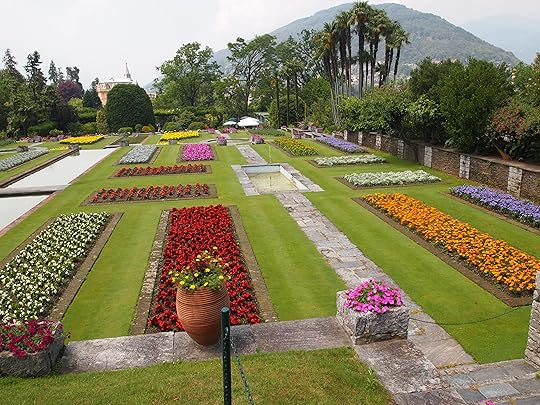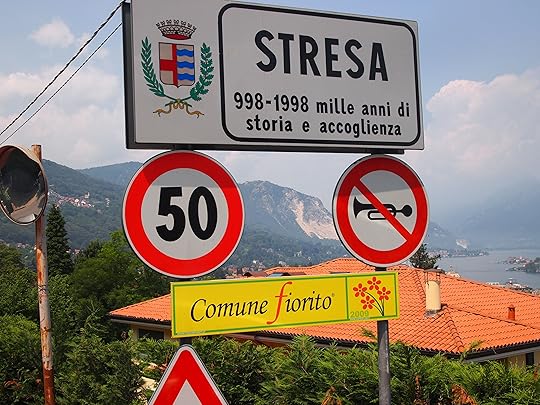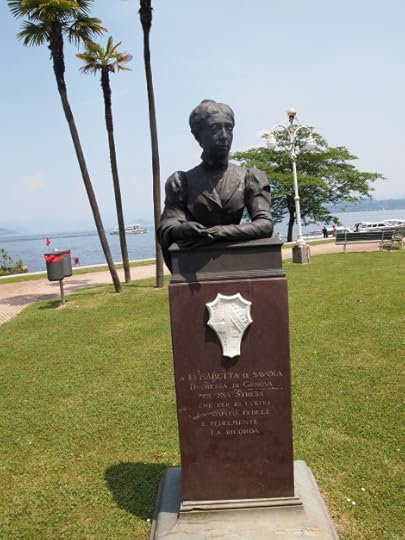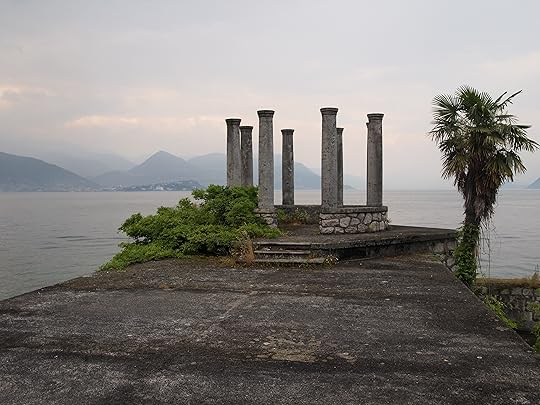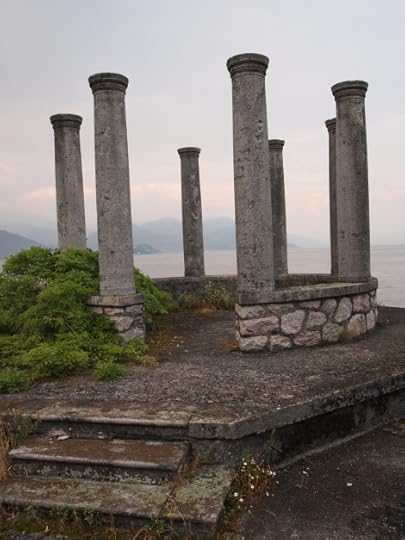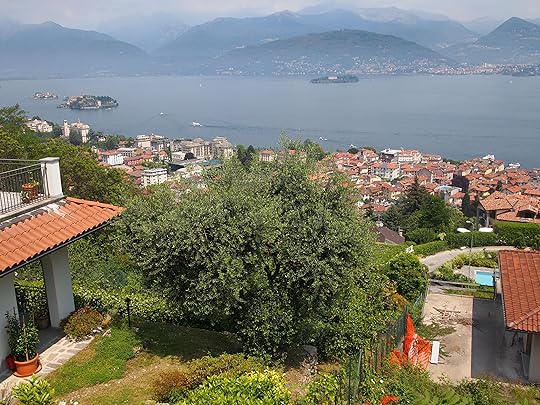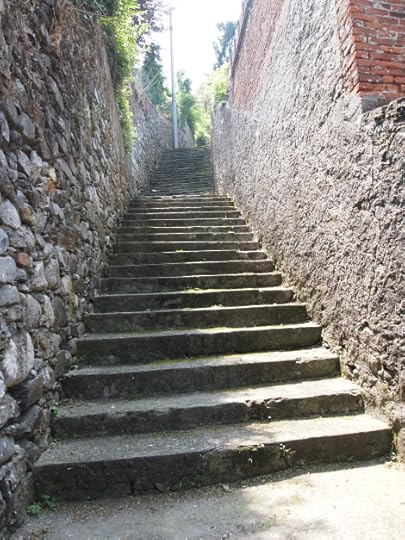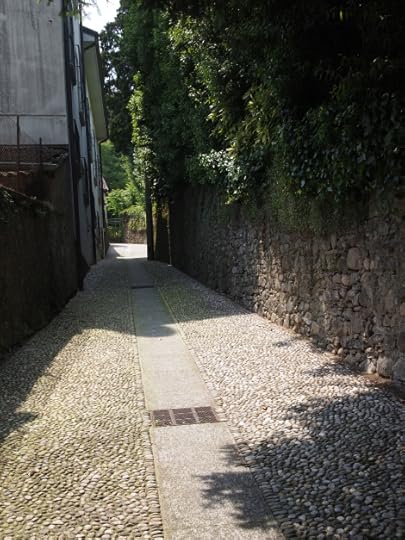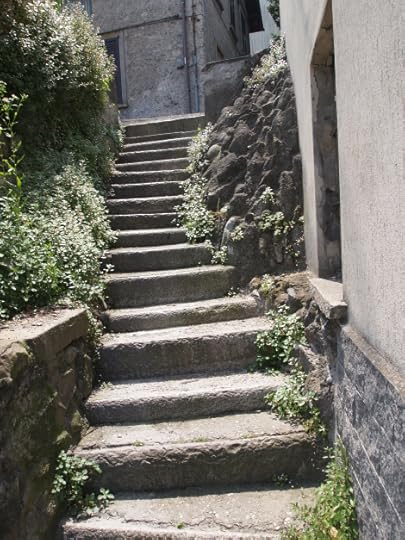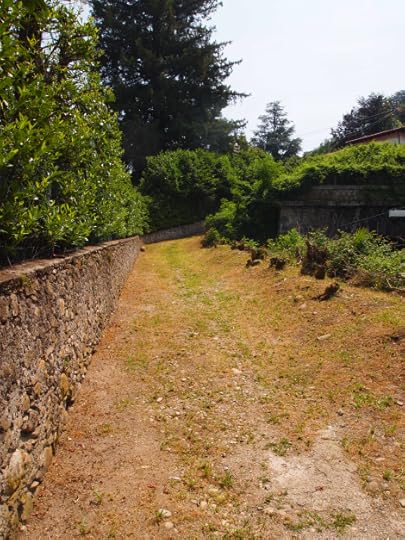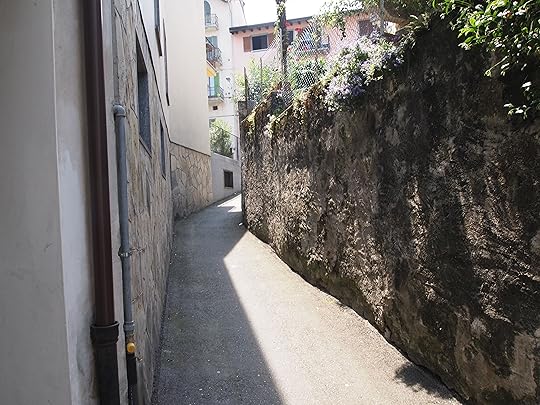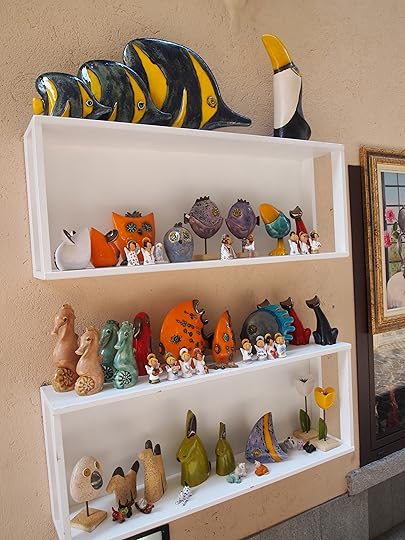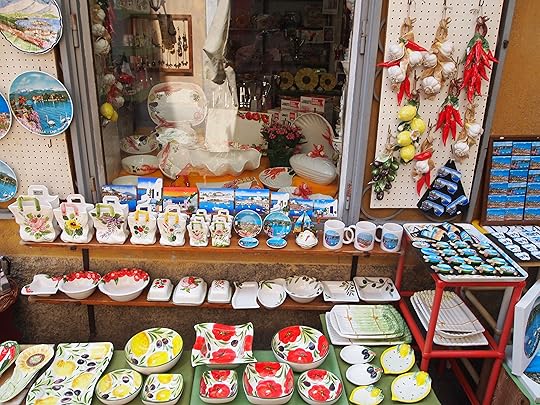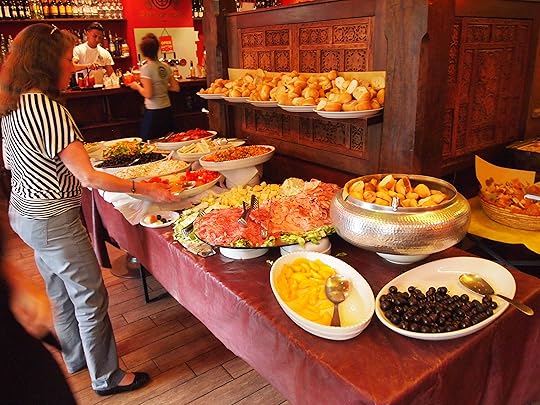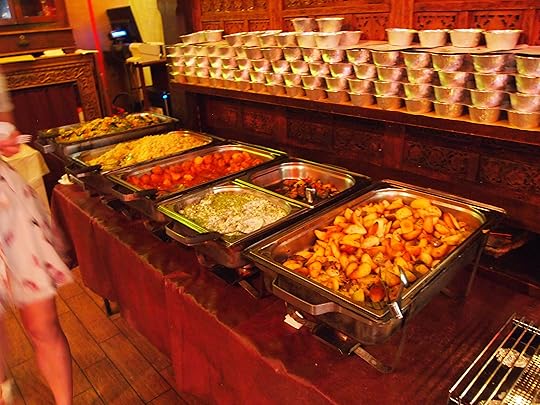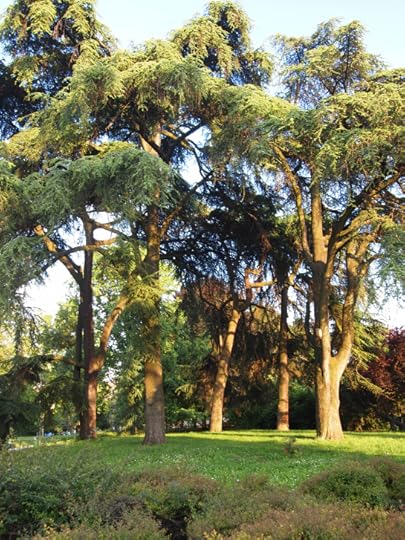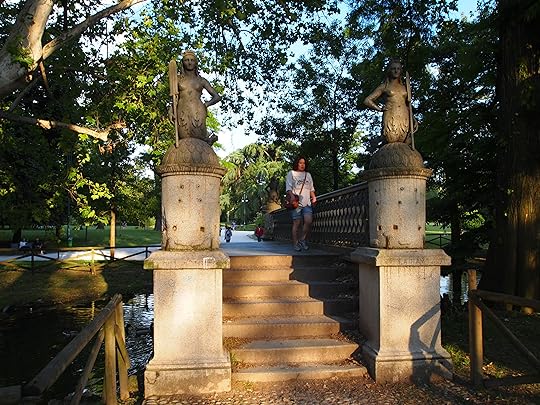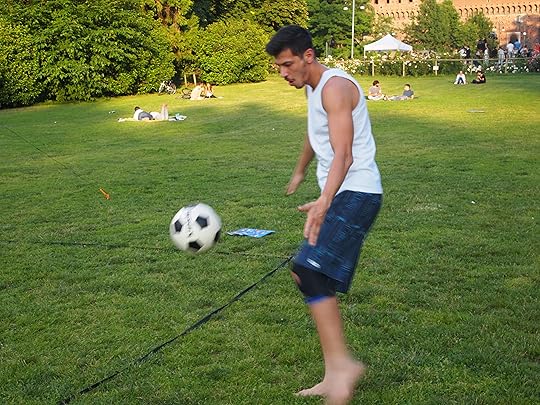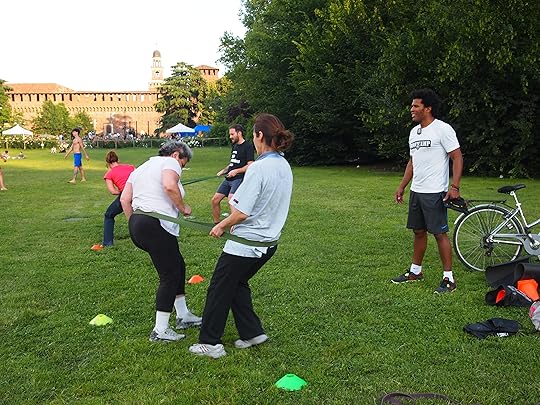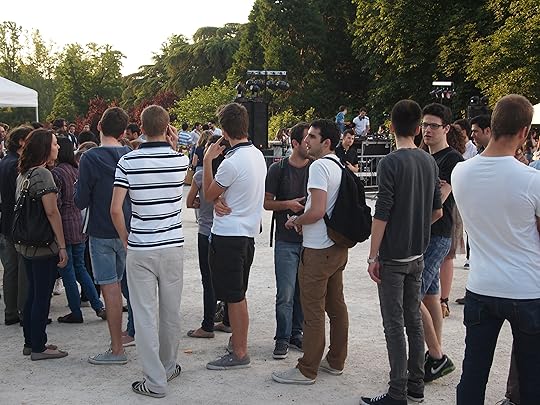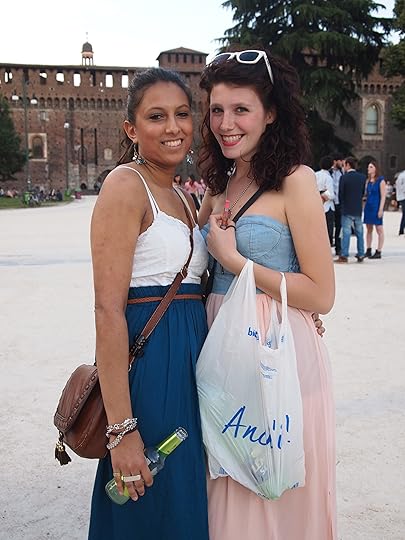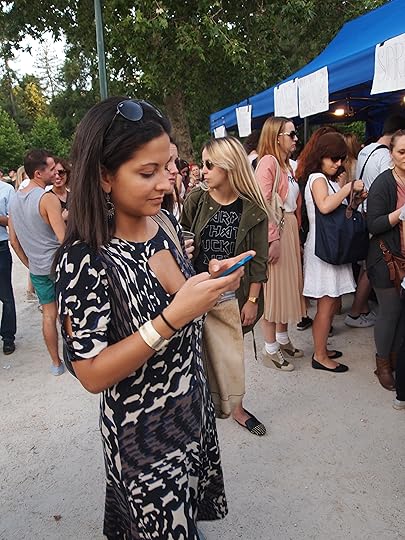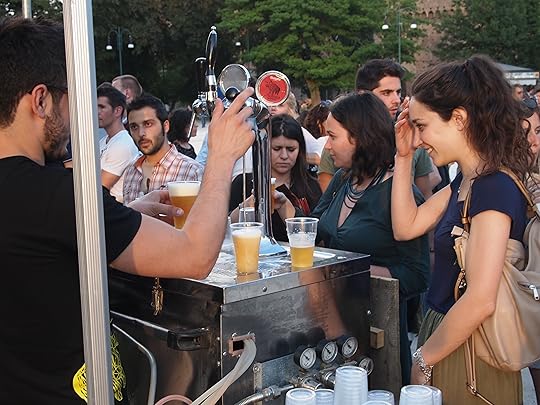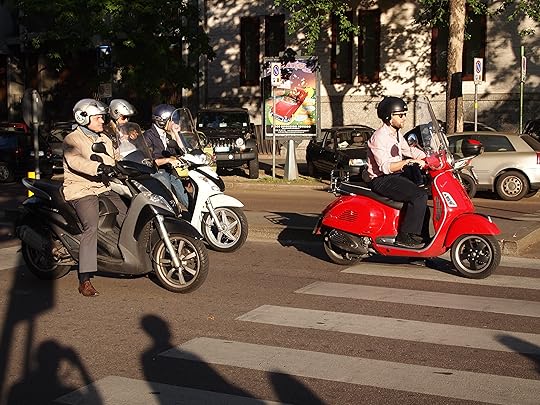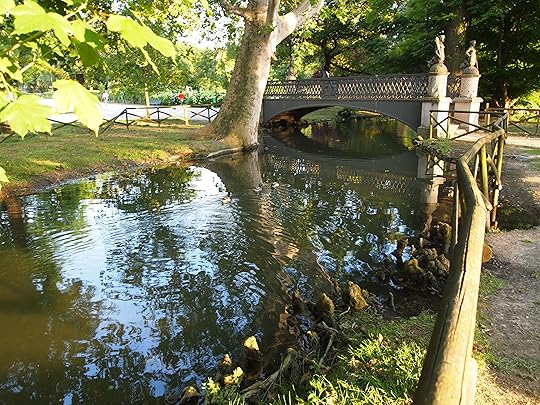Jack Erickson's Blog, page 4
July 8, 2013
Aare River
Aare River
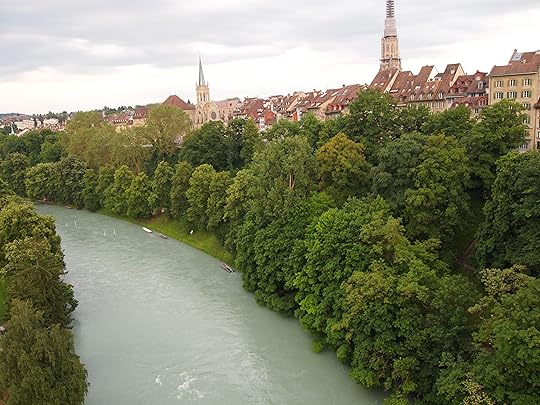
Aare River from Kornhausbrucke
The Aare River is a life force in Bern, carving a narrow peninsula around a bend in a wooded river valley. The river created a need for bridges to reach the aldstadt. Today, there’s a nature park along its banks. The Aare flows only in Switzerland, originating in a glacier, flowing through two lakes before it reaches Bern. Here is a map of the Aare River.
Five bridges cross the Aare. One day I crossed all of them to explore different parts of the alstadat. From the Kornhausbrucke which I crossed many times, you can see the Aare’s milky green currents and understand its importance in Bern’s thousand-year history. On an early Sunday morning walk, I looked down from the Kornhausbrucke and saw a narrow walking bridge beneath. I had no idea I would cross that bridge later in the evening.
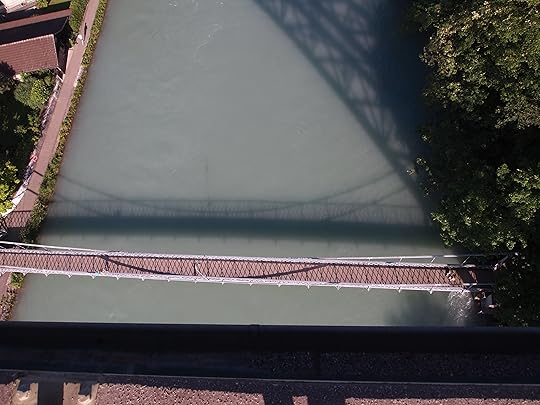
Pedestrian bridge below Kornhausbrucke
Rosengarten

Bern Rosengarten
I started my morning by hopping on a tram for a visit to the neighborhood, a quiet, modern area with parks, schools, apartment buildings and shaded streets. Bern has a superb public transit system, clean, modern, punctual. Miss a bus or tram check the digital monitor to see when the next one is coming by. Eight minutes was the longest I had to wait.
My destination was the Rosengarten above Bern where the Aare carves its horseshoe bend. The garden was wonderful, well maintained with wide paths, plenty of benches, not a drop of litter. Trill of songbirds was especially delightful. I strolled through the gardens, took too many photos, watched families, tourists, pensioners, and young lovers holding hands. Everyone looked so content. No wonder.
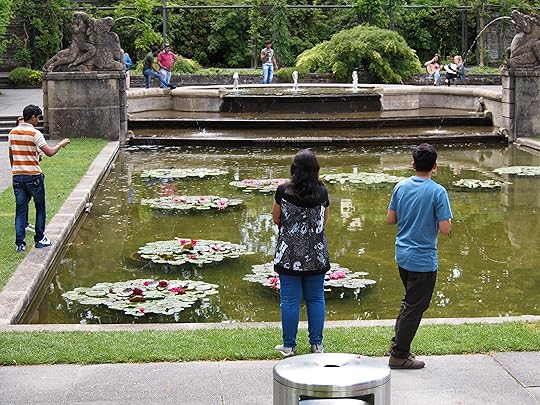
Lily pond
I watched grandparents taking their granddaughters through the gardens. The girls were possibly twins dressed identically, include cute white, frilled caps. The literally danced through the garden. What a nice moment.
Bern panorama
The rosengarten had been recommended because of the panoramic views of Bern, the Aare, and the aldstadt. So true.
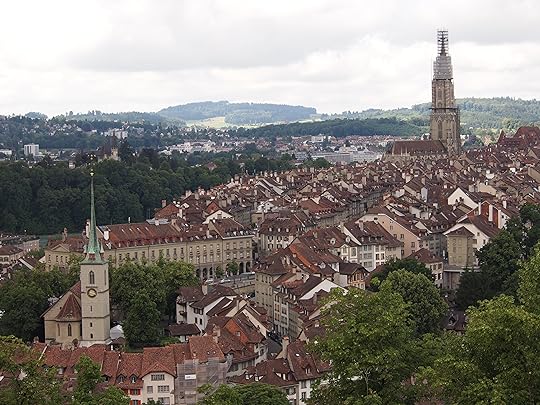
Bern panorama from rosengarten
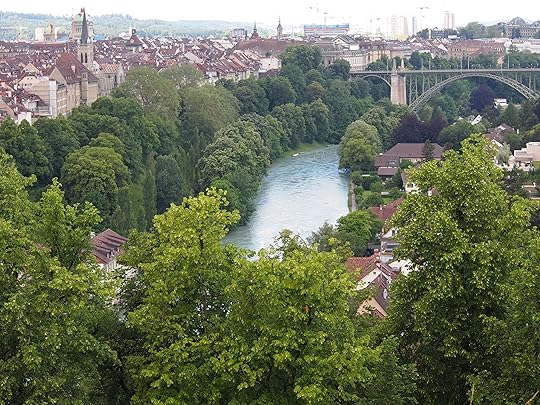
Aare river from rosengarten
I found a cobblestone path which descended the hillside and shaded by trees. I followed, admiring the views, the serenity, and gentle decline to a street that led to Nydeggbrucke. A word to those who might visit Bern and go to the rosengarten; if you take the path go down . . . not up. The cobblestones make it a bit challenging.

Cobblestone path down to Bern
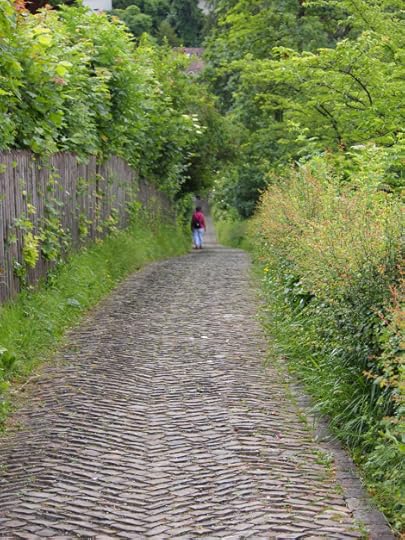
Peaceful stroll out of rosengarten
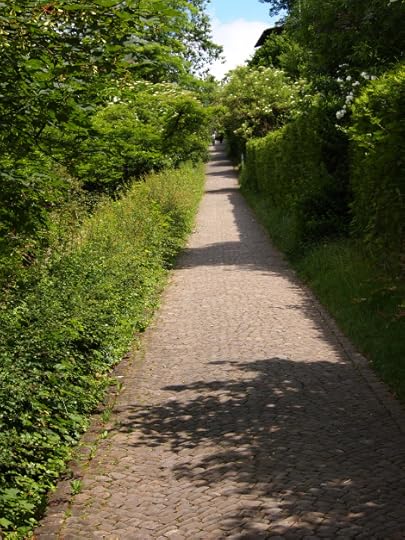
It’s a steeper walk up the cobblestones
Brucke
I heard loudspeaker booming, crowds cheering, and rock music blaring. Bern was hosting European mountain bike event, crazy guys bouncing, jumping, twisting bikes to navigate over logs, tree stumps, and stone blocks in an enclosure that looked like a bear pit in a zoo. Bikers, young men all, were timed as they made their way over the tortuous course. Can you believe some of these obstacles?

Don’t try this at home
Nydeggbrucke and Kirchenfeldbrucke

Nydeggbrucke over the Aare
After watching for a half hour, I walked across Nydeggbrucke into the aldstadt and continued exploring. Later in the afternoon, I crossed Kirchenfeldbrucke which had busy bus, auto, and tram traffic.
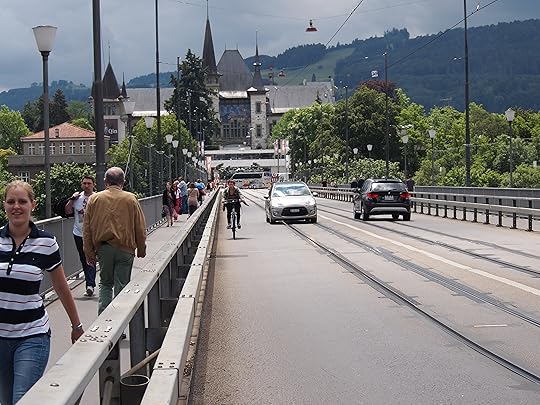
Kirchenfeldbrucke

River diversion system
Again I was rewarded with views of the Aare, but this time, I noticed a dam that directs water out into a channel rather than along the city’s walls.
Aare Riverwalk
I spent the day walking through the aldstadt, crossing bridges, having lunch, but I still wanted to experience more. There was another adventure I wanted, walking along the Aare. I walked down a shaded stone path to the riverbank where there was a restaurant and small park.

Aare river

Bern view from Aare river
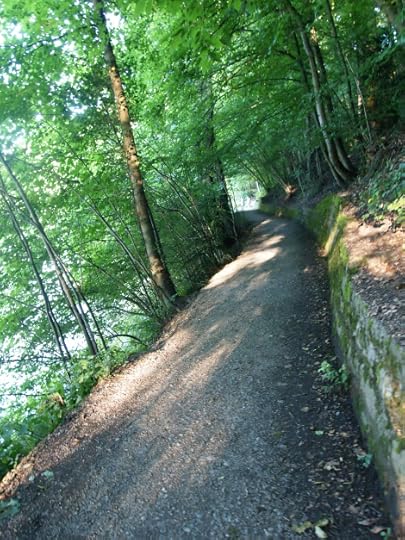
Trail through the woods along the Aare

Nydeggbrucke from the river view
Bear Park
The symbol for Bern is a bear going back to an early legend of the first animal hunted before the city was first built. To acknowledge the role of the bear in Bern’s history , there’s a small bear park below the Nydeggbrucke.
Meeting on walking bridge
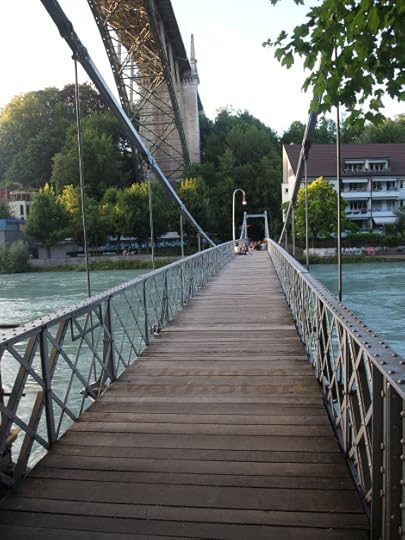
Pedestrian bridge across the Aare under Kornhausbrucke

A pleasant June evening on the Aare
Pleasant encounter on the walking bridge
I came to the narrow walking bridge I’d seen earlier in the day looking down from Kornhausbrucke. I met two young Swiss women on the bridge; we had a nice chat, took photos, and wished each other well. A nice encounter.

New Swiss friends
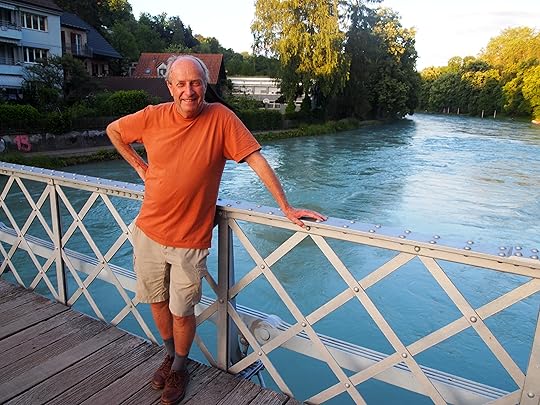
End of a delightful evening walking along the Aare
I ended the evening, walking up a path to Lorrainbrucke which I had crossed my first day. It was still light and thought I’d stop for a beer before returning to my pensione. I met three Germans from former east Germany who work construction in Bern. We had an interesting conversation, sharing stories in German, Russian, and Italian.
* * * * *
Next: Thun and Spezia
Please share your comments, i like to hear from readers and travelers.
I recently published my first international thriller, Thirteen Days in Milan, which is available on Kindle as well as other ereaders, tablets, and smartphones.
I’m back in Europe for the summer to hire a translator and to research my next book which will also be a thriller based in Milan. I’ll be posting along the way from Milan, Stresa, Zurich and other locations.
I have a few posts on another blog, Anatomy of a Thriller, where I write about the process of researching and writing an international thriller. I’ll add more posts there as well.
Please share these links with writers or readers who might be interested.
http://www.jackerickson.com
Find my books in Apple’s iBookstore
At Barnes & Noble
At Amazon including # 1 Kindle best seller “Perfect Crime”
View my Smashwords profile:


July 4, 2013
Bern Aldstadt
Bern Altstadt
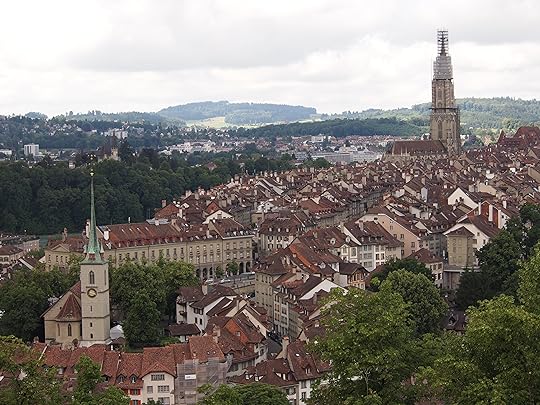
Bern panorama
The capital of Switzerland is a semi-medieval city with centuries old stone buildings on a narrow peninsula where the Aare River makes a horseshoe bend in a wooded river valley. The Aare is a 183 kilometer long tributary of the Rhine River and only exists in Switzerland.
The founder of Bern was Duke Berchtold von Zahringen chose the site in 1191 because it was easy to defend. Three sides were protected by the Aare river which was like a moat, dangerous and difficult for possible invaders to consider crossing.
Ascona to Bern
I took a train from Ascona near the Italian border through central Switzerland to Luzern then west to Bern. Early parts of the journey were though many tunnels through the alps, then opening into beautiful views of valleys and lakes.
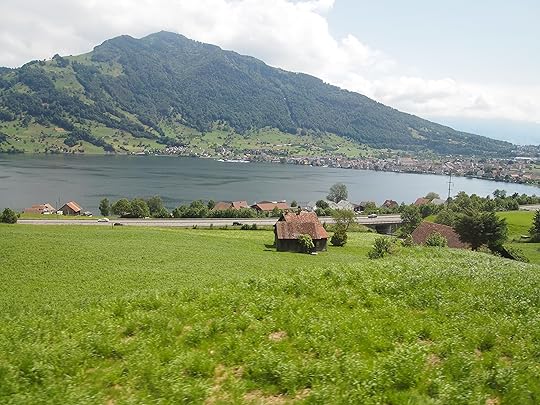
Pastoral Switzerland
Swiss capitol since 1848
In the middle ages, Bern was one of the largest and most powerful city states north of the Alps. But in 1405, all the wooden buildings in Bern burned down and the city was rebuilt with sandstone. Many of those building still survive in the ‘aldstadt,’ old town.
Today the once powerful medieval town is a major European capital and home to wealthy Swiss who want luxury, safety, privacy, and serenity. It’s all here. Bern became the capitol of Switzerland in 1848 when the country was confederated.
Summer Solstice in Bern
My first night in Bern was on June 21, summer solstice. After an afternoon strolling through the aldstadt, I noticed that it was not getting dark. Saturday night was busy in the aldstadt, I didn’t want to miss any of the fun. The Berners didn’t either.
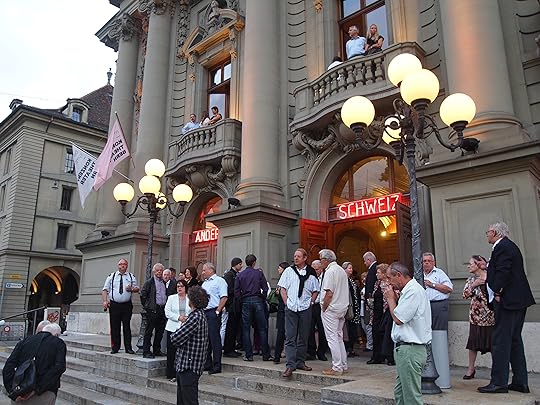
Saturday night at the Konzerthaus
Five Bridges
The aldstadt is on the peninsula in a river valley surrounded by steep hillsides where most Berners live in apartment buildings along quiet, shaded streets. To reach the aldstadt, you cross one of five bridges which also serve as tram and bus routes into town.
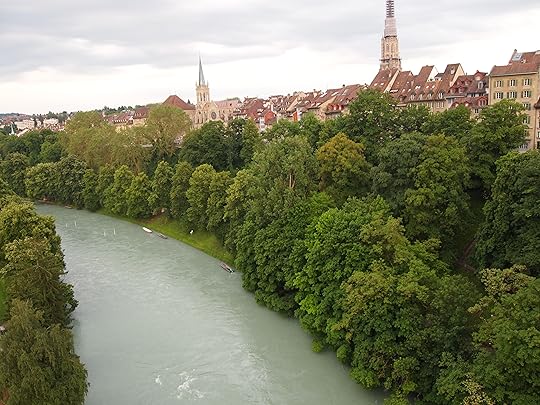
Crossing the Kornhausbrucke over the Aare River into Bern

Nydeggbrucke over the Aare
Each crossing allows one to look down into the river and see the beautiful panorama of the Bern’s clock towers, church steeples, medieval buildings, and cobblestone streets.

Aldstadt near the Aare River
Zytglogge
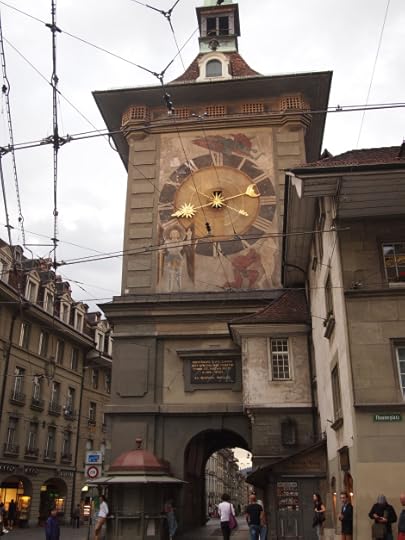
Zytglogge – Bern’s first city gate
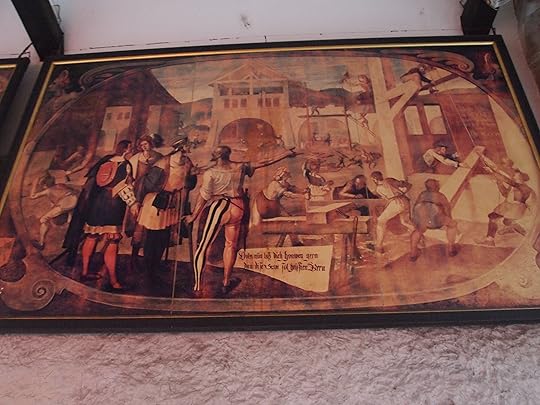
Mural under Zytglogge’s arched passage
A fifteen-century clock tower is the focal point of the aldstadt. The giant clock was the original gate of the city. Giant clocks are on both sides, with the side facing the aldstadt featuring an astrological calendar and a Swiss statue.

Side of Zytglogge facing medieval city streets
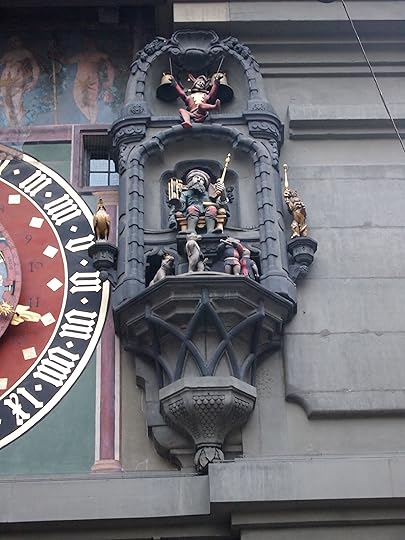
Legendary medieval statue

Astrological calendar on Zytglogge
Three wide, cobblestone streets run the length of the peninsula to the Aare River. Centuries old building are now apartments, offices, and street level restaurants, coffee shops, designer stores, artists studios, and professional offices.

Rauthausgasse in the aldstadt

Gerechetigkeitgasse
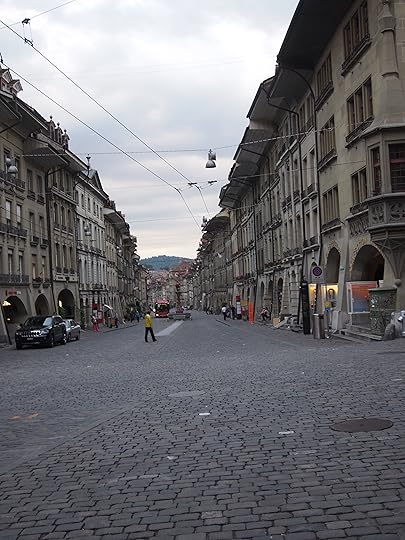
Kramggasse in aldstadt

Aldstadt promenade
Murals in the aldstadt
A number of buildings had festive murals depicting what looked to be caricatures of old Swiss peasant life. Very interesting and colorful. I wish I could have learned more about them.
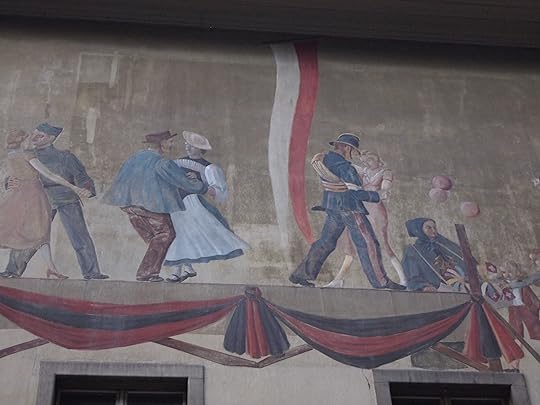
Swiss peasant life mural on altstadt buildings
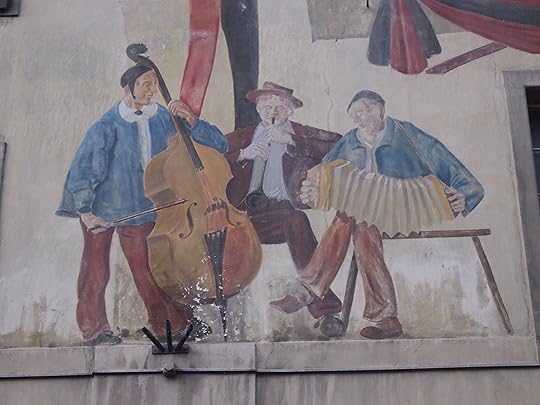
They’re having a good time!
* * * * *
Next: Aare River
Please share your comments on our travels.
I recently published my first international thriller, Thirteen Days in Milan, which is available on
July 2, 2013
Villa Taranto
Villa Tarant0
 Across from bay from Stresa is an area known as Verbania, from the name Verbano, which is what the Romans called the area when they first occupied it. Today Verbania is a few small towns along Lago Maggiore, Palanza, Villa Taranto, and Istra on a peninsula. Ferries make the route to Isole Barromeo and the hillside towns for tourists or residents alike. You hear proper English, German, French, Norwegian, Japanese, and Italian of course.
Across from bay from Stresa is an area known as Verbania, from the name Verbano, which is what the Romans called the area when they first occupied it. Today Verbania is a few small towns along Lago Maggiore, Palanza, Villa Taranto, and Istra on a peninsula. Ferries make the route to Isole Barromeo and the hillside towns for tourists or residents alike. You hear proper English, German, French, Norwegian, Japanese, and Italian of course.

Lago Maggiore ferry
After an hour walking around Palanza, I boarded another ferry to sail around the Verbania peninsula. Along the way, we passed another small island, Isola San Giovanni, which is just a few meters from the mainland. It looks like there’s a villa on the island, the rest of heavily wooded. Some splended villas are on the hillsides with great views of Lago Maggiore.
Villa Taranto is a legacy of Scotsman Captain Neil Mc Eacharns who gathered thousands of plants and flowers from around the world to create this wonderful garden. He bought the Villa La Crocetta in 1931 intending to reproduce an English-style garden in a place that reminded of his Scottish homeland. He did a splendid job and his dream lives on today for all who visit.
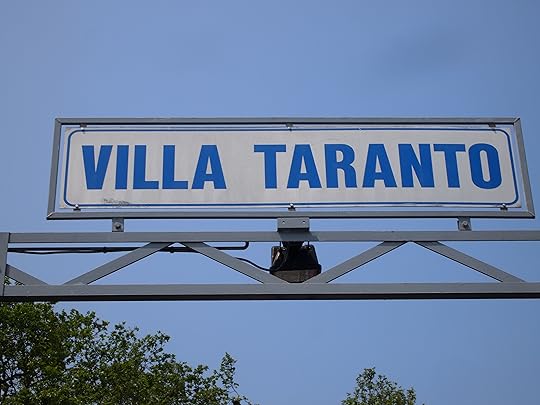
Dock at Villa Taranto
I bought a ticket and decided to have lunch on the patio just outside the entrance. I had a salad, a refreshing beer, and watched others arriving and entering the gardens. I was eager to see this wonderful place I’d read about in guidebooks.
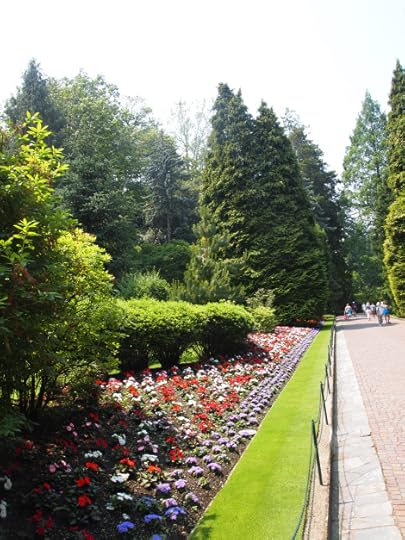
Entrance to Villa Taranto
The entrance to Villa Taranto is along a gravel path through mature pine trees and beds of impatients and petunias. The layout for Villa Taranto is quite impressive, well-marked paths wind through the hillsides with sections dedicated to various flowers and trees. The first area is a broad, well-maintained lawn and flower beds with a fountain at one end and lily ponds and a small chapel at the other. 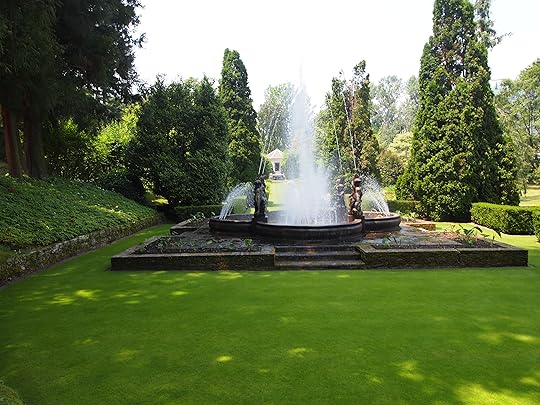
The first section featured tropical plants including coffee tree, palm trees, and nursery with Australian water plants similar to what we saw our visit Down Under in 2012.

Coffee tree with red berries like we’d seen in Costa Rica in January
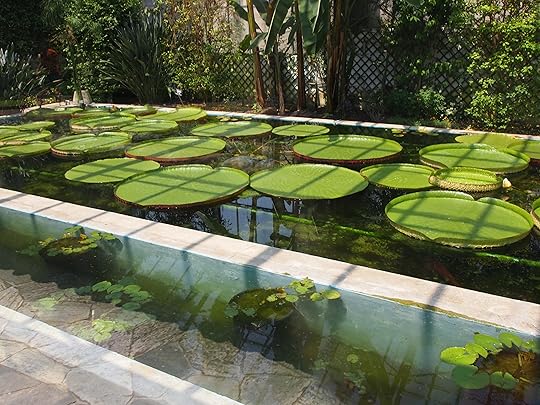
Australian water plants
Dwarf Asian maple trees
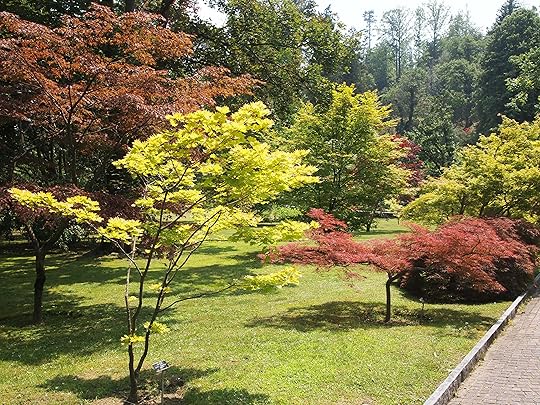
Grove of dwarf maple trees
The next section featured small trees that looked similar to Japanese maples with varying shades of green, purple, and violet. They looked fragile, requiring careful pruning to make the best presentation.
Villa Taranto flowers
Then there were the many flowers; iris, lilies, geranium, coleus, impatients, azaleas, rhododendrons, and many whose names I did not know. They were so beautiful and well cared for by experienced gardeners.
Paths through Villa Taranto
The rest of the afternoon, I followed paths with arrows guiding you through various areas of Villa Taranto. The gardens are very well maintained, trees and flowers pruned, paths litter-free, with wooden benches to stop and admire the beautiful flowers, plants and trees. A wonderful way to spend an afternoon on Lago Maggiore. 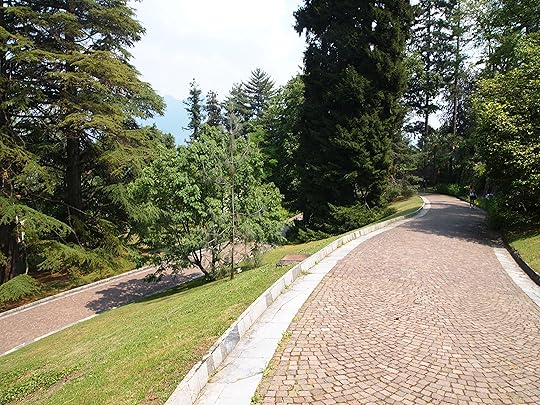
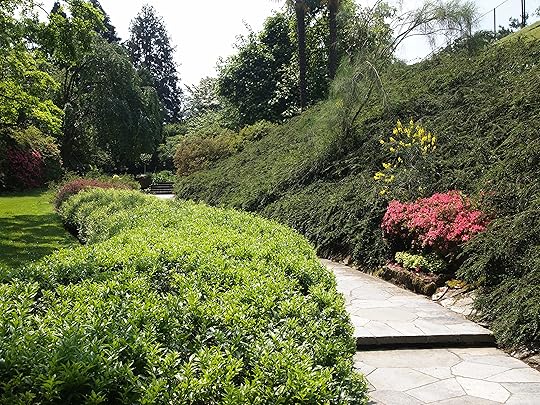
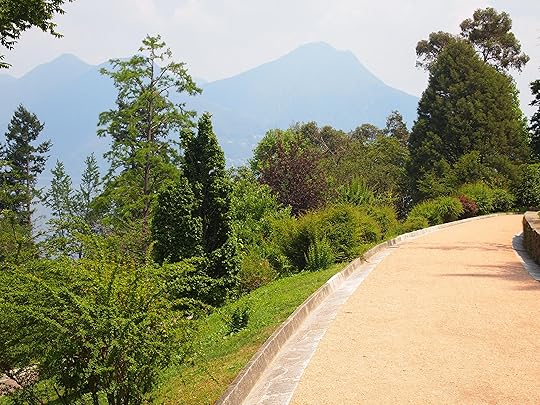

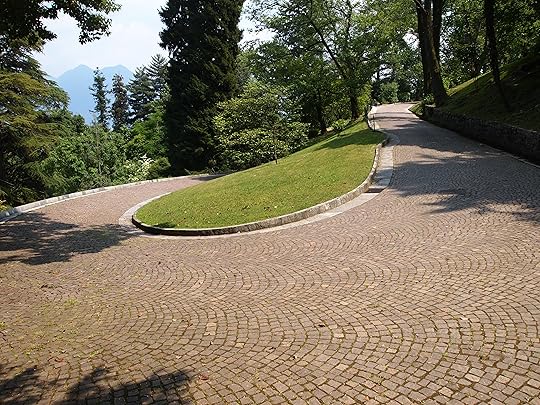
Visit Villa Taranto on your next trip to Lago Maggiore. I’m bringing my wife later this month for her to enjoy. She likes gardens as much as I do.
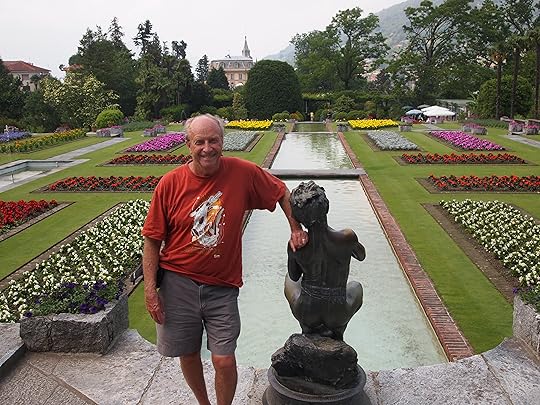
Share Villa Taranto with me
Next: Bern, Switzerland
I recently published my first international thriller, Thirteen Days in Milan, which is available on Kindle as well as other ereaders, tablets, and smartphones. I’m back in Europe for the summer to hire a translator and to research my next book which will also be a thriller based in Milan. I’ll be posting along the way from Milan, Stresa, Zurich and other locations. I have a few posts on another blog, Anatomy of a Thriller, where I write about the process of researching and writing an international thriller. I’ll add more posts there as well. Please share these links with writers or readers who might be interested.
http://www.jackerickson.com
Find my books in Apple’s iBookstore
At Barnes & Noble
At Amazon including # 1 Kindle best seller “Perfect Crime”
View my Smashwords profile:


June 24, 2013
Stresa on Lago Maggiore
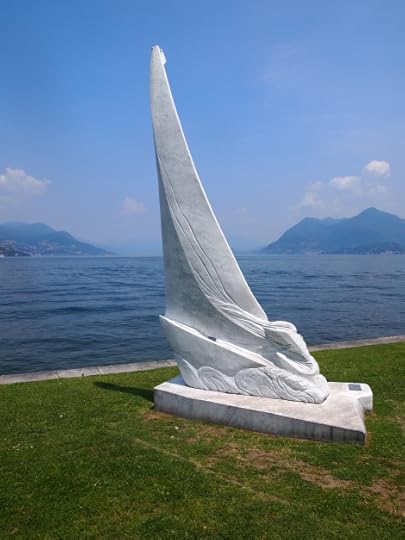
Modern sculpture from locally quarried white marble
Stresa is a picturesque town on the southern shore of Lago Maggiore, the second largest lake in Italy. It’s been a vacation spot for years; Dickens, Stendal, Hemingway spent time here, wrote about its beauty and relaxed lifestyle.
Stresa is only a 45 minute train ride from Milan’s Stazione Centrale, or 2 hours from Cadorna station, ending in Laveno on the other side of Lago Maggiore. From Laveno its a 15 minute ferry crossing to Istra, and another 15 minute ferry to Stresa. It may take longer from Cadorna, but you see more of the Lombardia countryside and get to first see Stresa from the lake, and not the train tracks.
Embankment
I spent a weekend last October at Stresa and was charmed by its many wonders, especially the embankment and the Borromeo islands off shore that can be reached easily by ferries or boats. The embankment is a wonderful way to experience Lago Maggiore, strolling along stone paths with blooming rose bushes, palm trees, lawns, memorial statues, and rocky beaches. You can relax on benches, sit on stone walls, or sip a cappuccino or a glass of wine at a lakeside restaurant. Gaze across at the Borromeo islands and towns like Laveno, Pallenza, and Baveno.

Ferries and tour boats depart often from the Stresa dock; hop on one and tour the islands

A couple relax in the shade of an embracing tree along the embankment
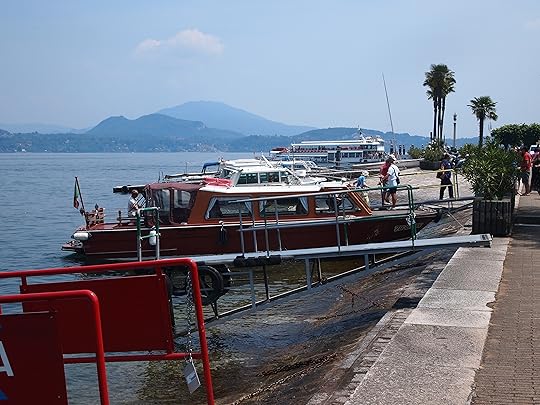
Private tour boats take you to the Isole Borromeo
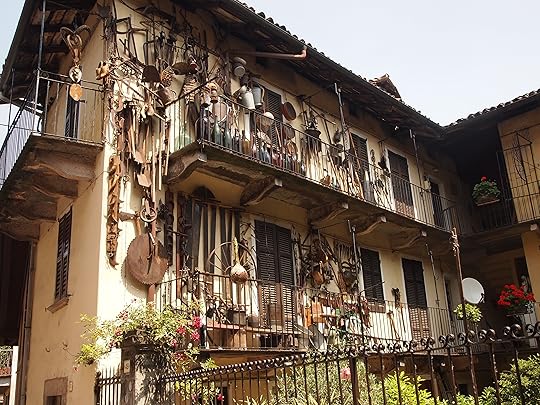
Antique metal tools collector; maybe he needs a garage?
Continue walking along the embankment outside of Stresa and you’ll discover unexpected delights such as these pillars on a small spit of land. Some years ago, someone reinforced the bluff with cement and erected these pillars which look Romanesque and somewhat mystical. I was curious, why were they built, what was their purpose, how was the site used. But there was no plaque to explain. I haven’t done research yet but probably will. In the meantime, let your imagination fill in the details.
Morning hikes in the hills
Stresa invites you to wander away from the piazzas into the hillsides to see the lake from above. Several small trails will take you to narrow stairways and paths that meander up the hillsides and reward you with splendid views of Lago Maggiore, the mountains, and islands. You can watch ferries crossing the lake, as well as small sailboats and a yacht or two. No cruise ships allowed. Lago Maggiore is almost pollution free with little debris on the shore. The water is deep blue, more intense and serene the higher you climb to admire the lake.
On your hike, you’ll pass beautiful villas with gardens, citrus and palm trees, swimming pools, and a tennis court or two. Oh, what would it cost to live in one of these splendid villas with spectacular views of Lago Maggiore?
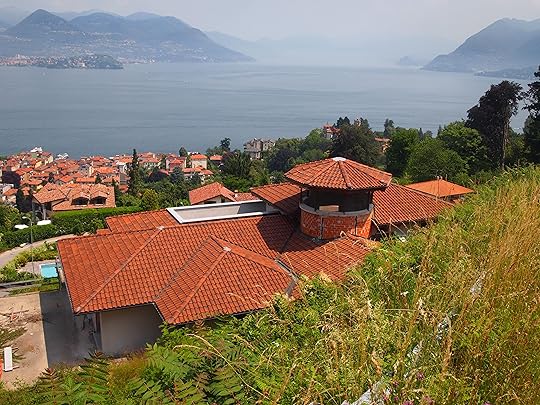
Hillside view of Lago Maggiore
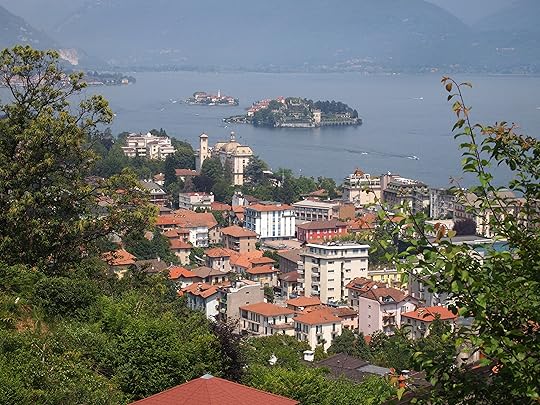
Isola Bella
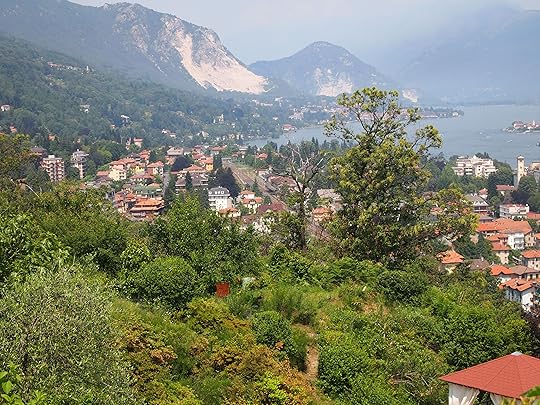
White marble quarries above Baveno in the distance
Many paths, trails, and lots of stone stairs
To see these splendid views of Stresa and Lago Maggiore, you need a bit of adventurer in your blood. There’s no maps, just wander and keep climbing, crossing narrow, winding roads that connect to smaller villages. Cross a road, and you’ll find a trail or stone stairs up the hillside. The higher you climb, the more rewarding are the views. Part of the fun is seeing how different the trails and paths are; again the mind wanders to when were they constructed, who has climbed over the centuries along the paths, and what stories those earlier Italians could tell.
Climbing up is a bit strenuous; bring water and a piece of fruit. You’ll want to stop several time to enjoy the views. It’s more fun to climb down, knowing your reward is having another cappuccino or glass of wine in the piazza below.
Isole Borromeo
Isole Borromeo offshore are charming and worth a day visit. Ferries stop first at Isola Bella, only ten minutes from the Stresa dock. There’s a villa with a museum, statutes, and gardens, and a few restaurants along the waterfront. If you don’t get off at Isola Bella, the next stop is Isola Superiore or Isola dei Pescatori, island of fishermen. In earlier times, fishermen lived in small stone houses on the island. Each home seems to have been converted into a cafe, coffee shop, restaurant, small hotel, or souvenir shop. You can walk cross Isola dei Pescatori in about a minute and pass two narrow paths about two-meters wide between stone buildings. It takes five minutes to get from one end of the island to the next.
The farthest of the Borromeo Islands is Isola Madre, about 25 minutes from Stresa if you stay on board. The island is a villa with a garden inside stone walls. But you don’t have to pay admission; stroll along a stone path around the island to see flowers, palm trees and beautiful views of Lago Maggiore.
Shopping in Stresa
There’s more to do than hike and take boat trips in Stresa. Shoppers can find interesting local crafts in shops along Stresa’s piazza and narrow streets. Many of the crafts can be purchased and stuffed into handbags, purses, and luggage as gifts for family and friends. Ceramics, soaps, perfumes, pastas, spices are attractive and reasonably priced. You’ll have nice mementos of your visit to Stresa.

Colorful ceramics for the kitchen

Shoes, shoes, shoes

Colorful pasta
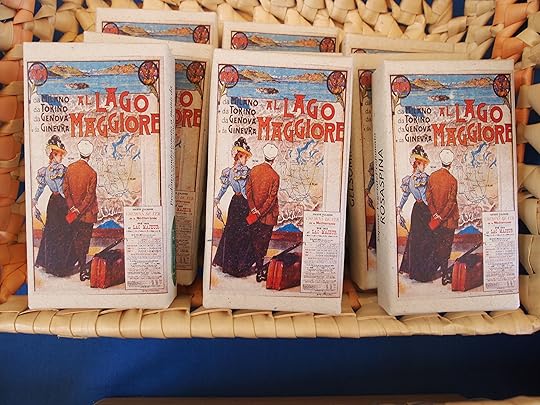
Commemorative soaps
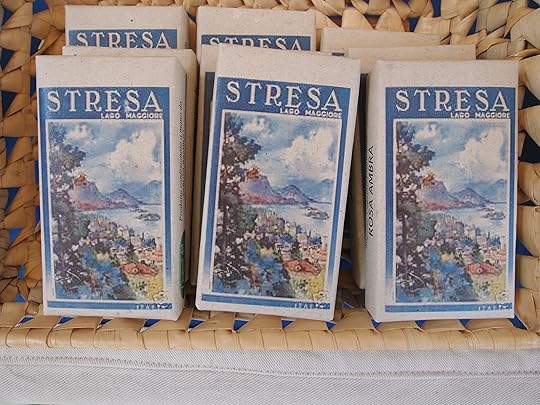
Stresa soap . . . buy a box for stocking stuffers!
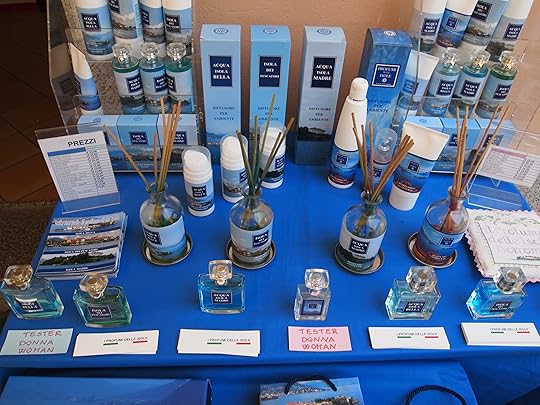
Perfumes
Let’s talk about Italian food . . .
No visit to Italy is complete without excellent food in memorable settings. No lack of good places to eat around Stresa. You’ll want to stop for a cappuccino during the day, a glass of wine before dinner, and a delicious pasta, pizza, or seafood in early evening. Italians don’t eat dinner until around 8 PM; many restaurants don’t open until 6 or 7 PM.
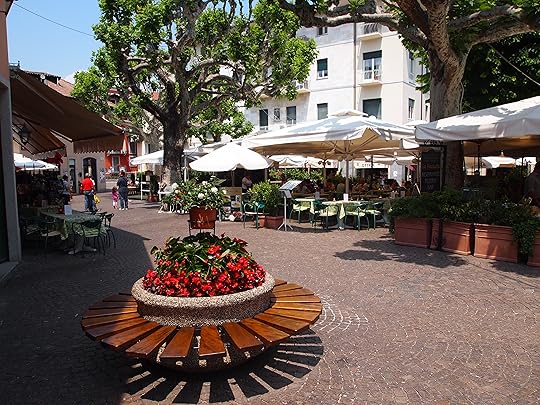
A dozen or so restaurants around the piazza
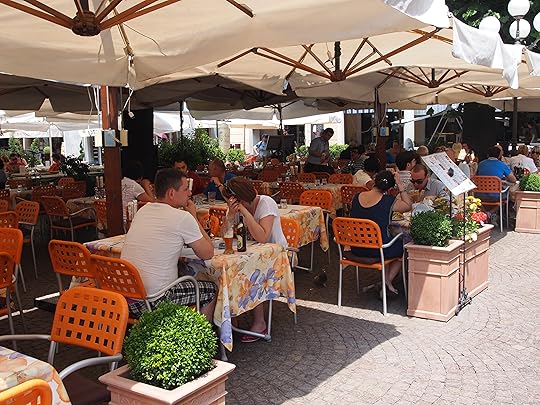
Is it time for pranzo yet?
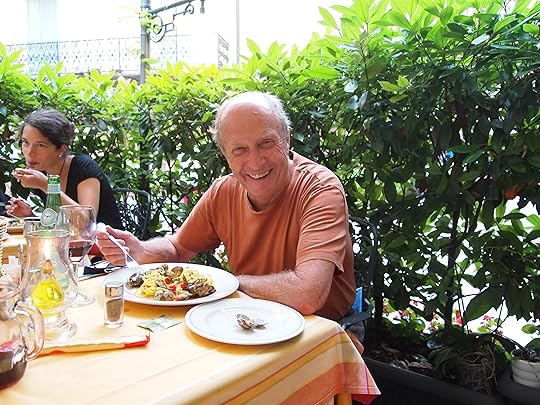
My favorite, spaghetti alla vongole!
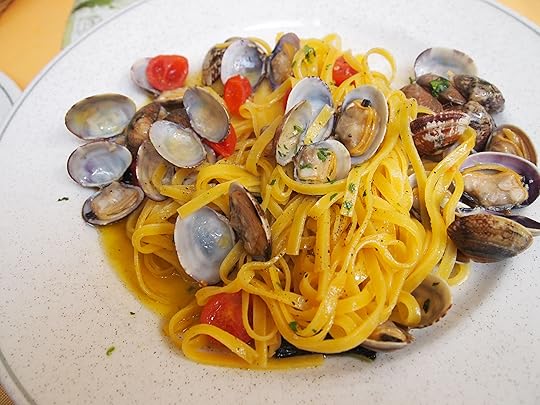
Que buonissimo!
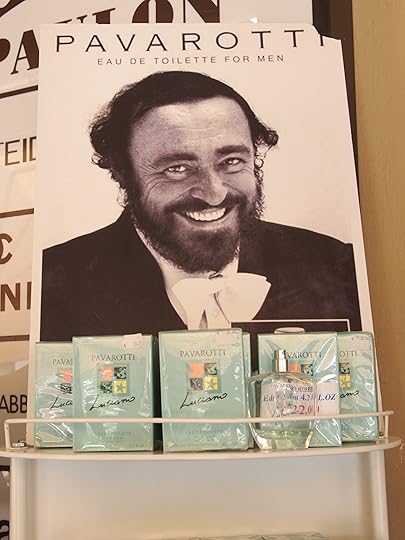
Someone else liked Stresa too
* * * * *
Next: Villa Taranta
I recently published my first international thriller, Thirteen Days in Milan, which is available on Kindle as well as other ereaders, tablets, and smartphones.
I’m back in Europe for the summer to hire a translator and to research my next book which will also be a thriller based in Milan. I’ll be posting along the way through Italy, Switzerland, Germany and France.
I have a few posts on another blog, Anatomy of a Thriller, where I write about the process of researching and writing an international thriller. I’ll add more posts there as well.
Please share these links with writers or readers who might be interested.
http://www.jackerickson.com
Find my books in Apple’s iBookstore
At Barnes & Noble
At Amazon including # 1 Kindle best seller “Perfect Crime”
View my Smashwords profile:


June 22, 2013
Milan, Parco Sempione
Parco Sempione
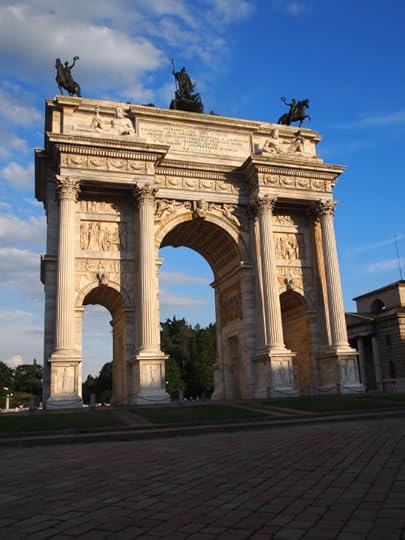
Arco delle Pace
Milan is blessed with city parks that are as much a part of the city as famous landmarks, the Duomo, La Scala, Brera Pinacoteca, and Leonardo da Vinci’s “Last Supper” at Santa Marie delle Grazie.
I discovered Milan’s beautiful parks in October 2012 when I was researching my thriller, Thirteen Days in Milan. I was checking various sites for an apartment or pensione convenient to downtown. The woman who became my researcher said the neighborhood was safe and it was an easy location to get around the city. After my first day, I was exploring the wonders of the park, which is like a mini Central Park with wide paths, mature trees, flower gardens, cafes, children’s area, and benches to sit and people watch.
It became a daily ritual, walking through Parco Sempione, having a meal at restaurants on Piazza Sempione, or hopping on a # 1 or # 19 tram to get around town. Within days, I felt right at home in the neighborhood.

# 19 tram I took daily along Corso Sempione
Apertivo
After a day of interviews, meetings, and prowling around the city, I’d return and have dinner at one of the restaurants at Piazza Sempione. Starting around 6 PM, restaurants serve all-you-can-eat buffet, or ‘apertivo,’ with trays of pastas, salads, cheeses, meats, pizza, risotto, seafood, fresh fruit, and breads. All for 8 or 9 Euros. One drink included, a beer, glass of wine, or bottled soda. The food was good, the atmosphere pleasing, and the view terrific . . . and I was five minutes from my apartment.
It’s an amazing bargain. When I visited in October, I thought it was just an end-of-the-tourist season special. But ‘apertivos’ are served every night. No need to spend 40 Euros and more at a fancy restaurant, just come on by Piazza Sempione and grab a plate. Sit outside under an umbrella and watch the people with the background of Arco della Pace.
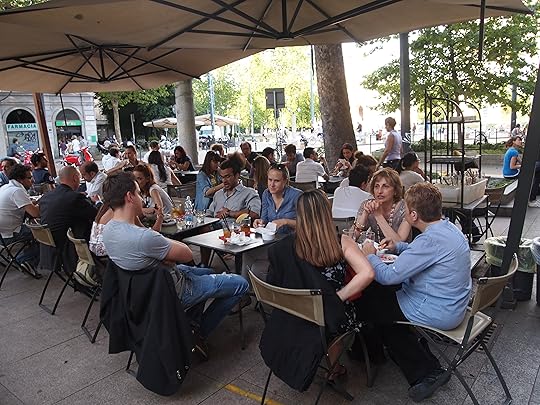
Apertivo at Piazza Sempione on a warm, early summer evening

Apertivo at Piazza Sempione
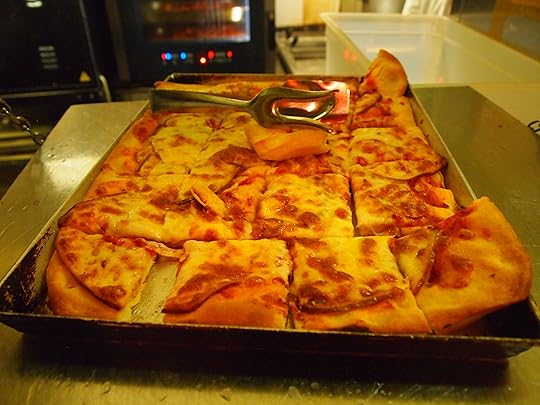
Fresh from the pizza oven
When I returned this month for related book business, I happily chose the same apartment on Via Melzi d’Eril, a semi-circular street that intersects the wide boulevard Corso Sempione.
Arco delle Pace
A cornerstone of the park on Piazza Sempione is the majestic Arco della Pace, a gothic, white-marbled arch inspired by Napoleon when his army occupied Milan and he was crowned King of Italy in 1805. Arco della Pace rests at the base of Corso Sempione, similarly inspired by Napoleon to resemble Paris’ Champs Elysee. The white marble seems to shine in sunlight, with teams of chariots cast in bronze peering from the top, in some kind of Roman gladiator splendor.

Arco delle Pace

Bas relief under Arco delle Pace arch
Summer evening at Parco Sempione
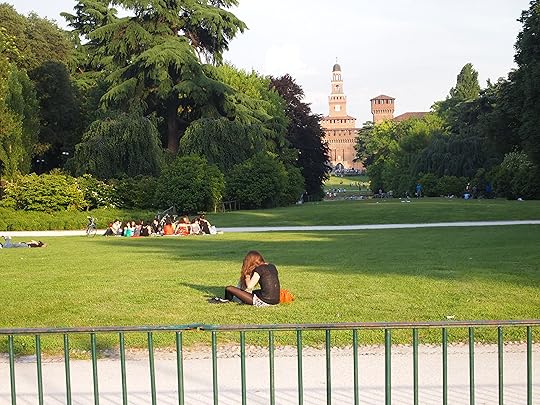
Castello Sforzesco in the distance

Castello Sforzesco from Arco della Pace
But it’s not monuments and boulevards that distinguishes Parco Sempione; it’s the many features that draw people into the park for a stroll on shaded paths, along canals, open fields, flowering bushes, or just rest on one of many benches. Look one direction and you see Arco della Pace. Turn the other direction and there’s Castello Sforzesco at the other end.
A creek runs through the park, shaded by tall trees, with carp swimming in pools and ducks paddling under bridges.
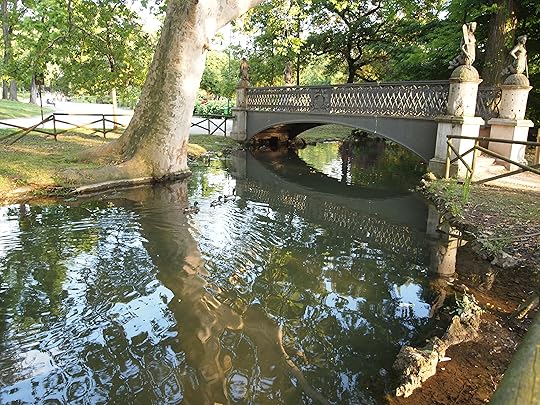
Mother duck leading her ducklings under a bridge
On a warm night in early June, I strolled through the park, attracted by the thump thump thumping of amplifiers playing in the park. It was Milan’s first day of summer; a dreadfully chilly and damp spring had lasted longer than usual. The weather brought out those looking for a little exercise, stretching muscles chilled by a long, cold winter, and a chance to run barefoot in the grass.
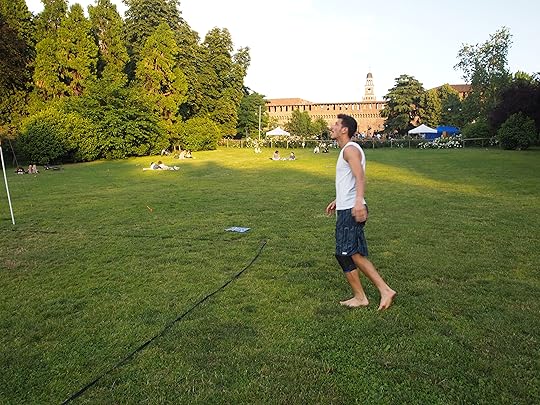
Playing soccer with a volleyball net
First time I’d seen this ‘no-impact’ exercise; stretching with rubber ropes. You need someone you trust as your anchor!

Not too far . . . just far enough . . . and don’t let go!
The music was loud but with a provocative beat, the crowd was young and frisky, and vendors selling wine and beer were busy.
I asked a few of the young folks if I could take their picture. They seemed to be thrilled to be asked; when you’re having a good time, no reason to keep it a secret.

Out for a night in Parco Sempione
I’ll return to Parco Sempione in July and August. It’s the kind of place that calls you back with its serenity, the towering trees, the shaded paths, comfortable benches, and the alluring singing of song birds.
A good escape from the buzz of motorinos zipping around Milano’s streets.
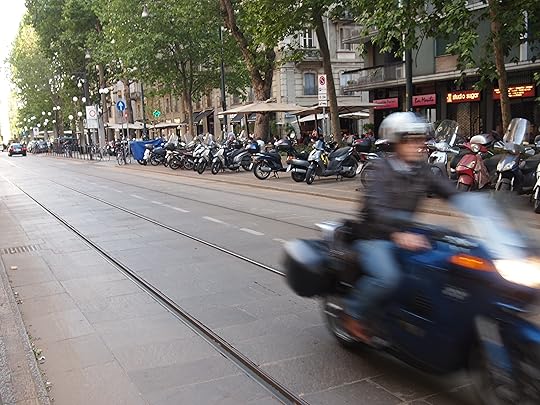
Zooooom!
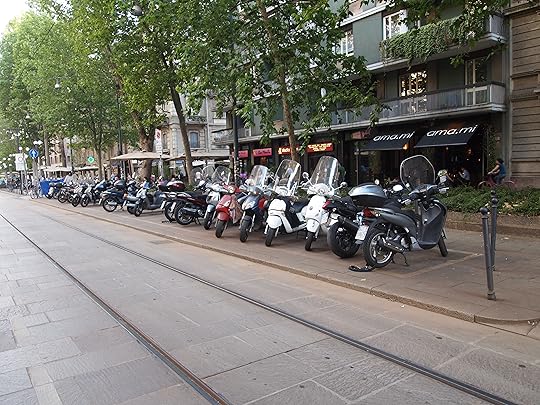
It seems everyone has a motorino: teenagers, students, parents, businessmen, and pensioners
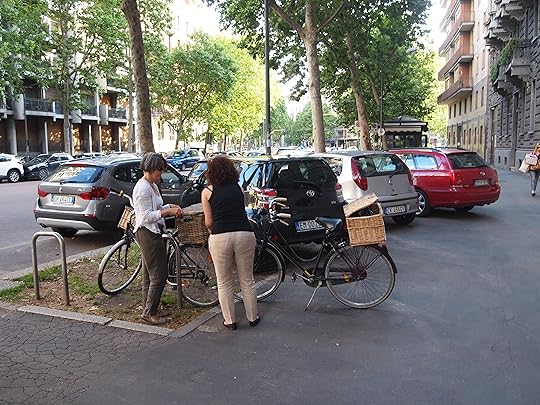
No reason to park on the street; use the sidewalk
I’d rather enjoy Parco Sempione with the ducks.
* * * *
Next: Stresa on Lago Maggiore
I’ll be returning to Milano in July and August. I have many fascinating places to show you in this very dynamic and historic city.
I recently published my first international thriller, Thirteen Days in Milan, which is available on Kindle as well as other ereaders, tablets, and smartphones.
I’m back in Europe for the summer to hire a translator and to research my next book which will also be a thriller based in Milan. I’ll be posting soon from Milan, Stresa, Zurich and other locations.
I have a few posts on another blog, Anatomy of a Thriller, where I write about the process of researching and writing an international thriller. I’ll add more posts there as well.
Please share these links with writers or readers who might be interested.
http://www.jackerickson.com
Find my books in Apple’s iBookstore
At Barnes & Noble
At Amazon including # 1 Kindle best seller “Perfect Crime”
View my Smashwords profile:


June 10, 2013
Coffee farm, Costa Rica
Coffee Farm
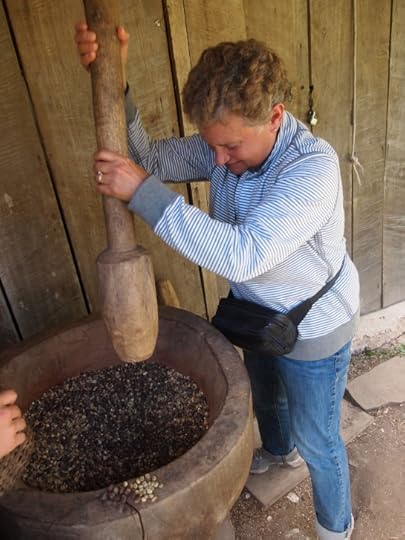
Lucy crushing coffee beans
Costa Rica coffee is world-famous, grown on terraced plantations on mountains facing the Pacific Ocean and Caribbean Sea. The ideal temperature, moisture, and soil produced plump , red coffee beans that produce rich, flavorful coffee high in caffeine. Coffee is the third largest export in Costa Rica after being the number one export for several decades. Coffee production began back in the late 18th century and by the 19th century, the government was encouraging coffee growing by giving farms land to plant coffee trees.
China has a free trade agreement with Costa Rica to import coffee which is becoming very popular in the traditional tea drinking nation. China is the second largest trading partner with Costa Rica, the U.S. is the largest trade partner.
After our cloud forest trek, we boarded a shuttled bus for a coffee farm on a hillside below Monteverde. On the drive down the mountain, we had a wonderful view of the Pacific coastline to the west and the Puntarenas peninsula.

Puntarenas peninsula from Monteverde
Don Juan Laiten
Our host was Juan Laiten, who farms 8 hectares on a hillside of which only 3 hectares are planted in coffee trees. Juan is part of a local cooperative of small organic coffee growers in the valley.

Juan Laiten, small coffee farmer
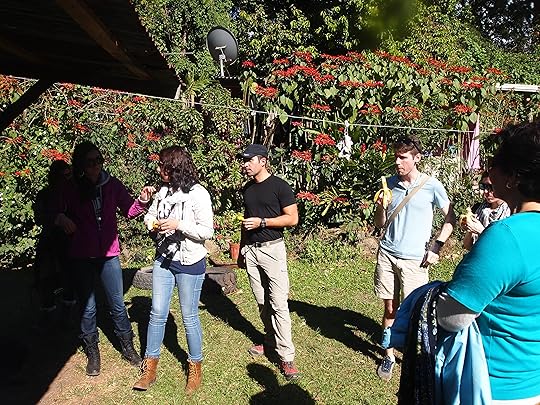
Touring Juan’s coffee farm
Cherry coffee beans
Coffee beans grow on branches of shiny green plants that are cropped to about 4 feet high. Farmers prune trees during the year to keep trees from growing too tall. Pruning makes it easier to pick with beans growing about waist-high.

Immature ‘green’ coffee beans

Cherry beans ready to pick
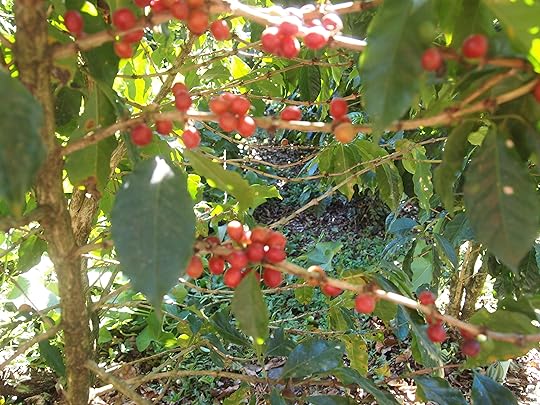
Cherry beans, ready for harvesting
The harvest season extends several months with mature berries turning red when they are ready for picking. Pickers walk down rows daily, lift branches, and pick only mature ‘cherry’ berries. If a picker’s box contains too many green beans, he is penalized and his pay drops.
Cleaning and husking cherry beans

Mature coffee ‘cherries’
Milling coffee beans
Cherry coffee beans are dumped into a mill where they are crushed, with the moist husk being separated from the bean. The cherry husk drops into a bucket where it is taken out and used as compost around the farm.

Crushing cherry coffee beans to remove skins
The white ‘husks’ are washed in the milling process and spill into a bucket where they are examined for whole husks then poured onto wooden trays and laid out in the sun to dry.

Washed beans out of mill, ready for drying rack
Drying beans
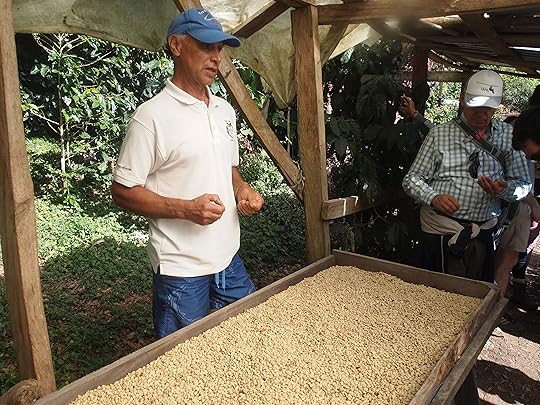
Juan explaining drying process
Tan coffee beans are dried on flat trays exposed to the sun for six or seven days. When they are dry and easy to crack open, they are put through a soft grinder which crushes the dry husk, exposing a small brown bean with the distinctive crease down the middle. This is the true coffee bean ready for roasting. Dried beans are taken to the local cooperative where they are roasted and packaged for shipping around the world as ‘fair trade’ coffee. Farmers who join cooperates agree to use environmentally sound methods and not use pesticides or chemical fertilizers.
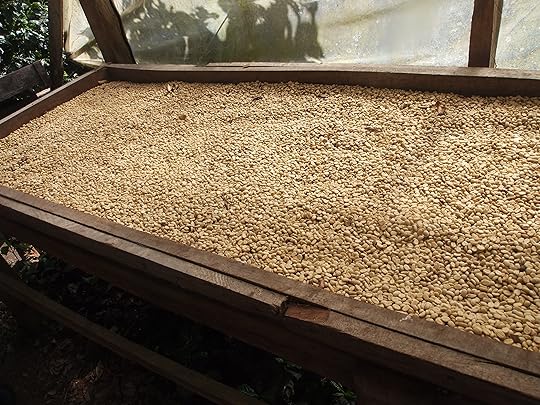
Rack of drying beans
Coffee, bananas, sugar, beans,
Juan is a small farmer who also grows sugar cane, bananas, and vegetables for his family. Tall banana plants shade rows of coffee beans.
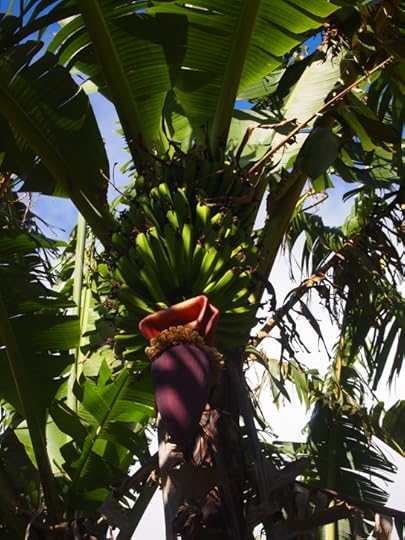
Banana tree on Juan’s small farm

Almost ready for picking
Coffee tasting with Juan
After walking through Juan’s coffee farm, we went along a jungle trail where he explained that part of being in a cooperative is preserving the natural environment. Indigenous animals, birds, butterflies, and insects are able to move through the valley and not be ‘boxed’ in by clear-cut, industrial farms.

Juan serving us fresh coffee and banana bread at his ‘hacienda’
Coming out of the jungle, we came to a small ‘hacienda’ that served as a tasting porch for guests. Juan had prepared fresh coffee for us to taste as well as fresh banana bread. He poured steaming cups for us and passed them around. It was delicious and very fresh, even for me who likes a spot of milk and a little sugar in my morning ‘cuppa.’

Mmm . . . good coffee!
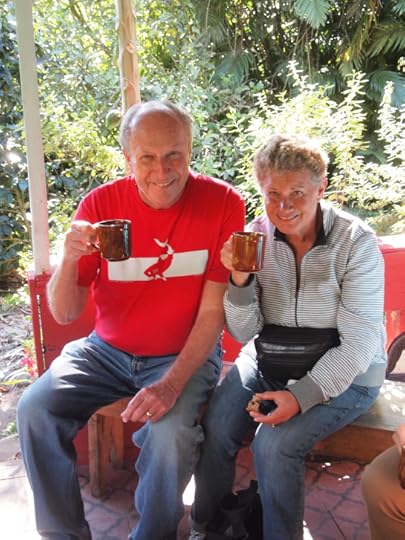
Freshest coffee we’ll ever enjoy
Our setting for the coffee tasting was surrounded by banana trees, and jungle flowers, ginger, hibiscus, wild orchids, and poinsettia.
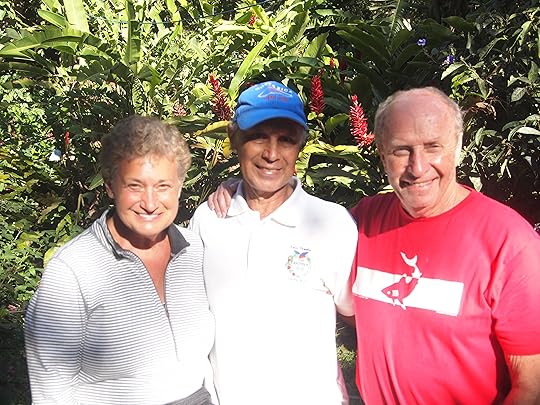
Surrounded by flowering plants around Juan’s ‘hacienda’
Juan’s cottage
Juan’s family lives in a small wooden building surrounded by tall, native poinsettia plants. When we walked down the dirt road to our van, I turned around and snapped a photo of the modest setting. Juan is a true pioneer, eking out a living on a few acres of coffee plants and vegetables he grows for his family.
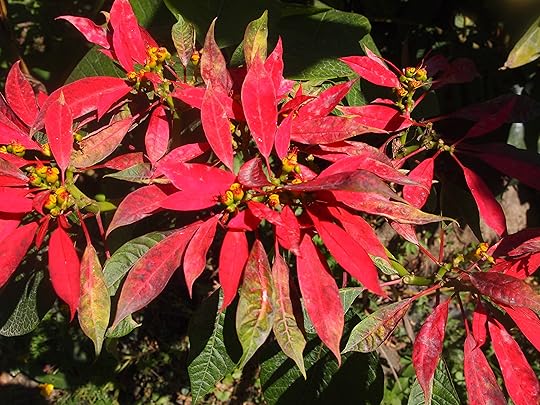
Poinsettia plants outside Juan’s cottage
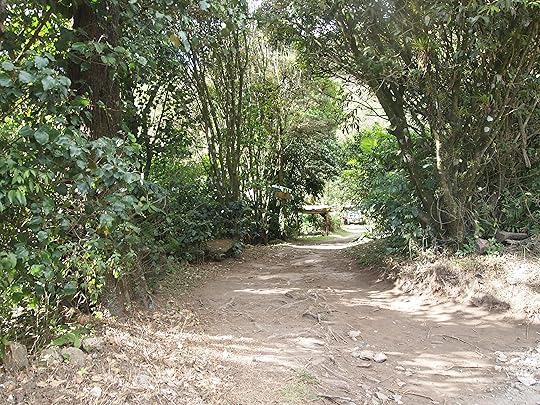
Road into Juan’s coffee farm
* * * * *
Welcome to our Central American travel adventures. Please share your comments with us, we’d love to
hear from you.
Next: On the beach at Manuel Antonio


May 16, 2013
Thirteen Days in Milan
Thirteen Days in Milan
My graphic designer delivered the cover of my new book yesterday.
In a few weeks, I’ll be publishing “Thirteen Days in Milan” on
February 4, 2013
2012 in review
The WordPress.com stats helper monkeys prepared a 2012 annual report for this blog.
Here’s an excerpt:
600 people reached the top of Mt. Everest in 2012. This blog got about 11,000 views in 2012. If every person who reached the top of Mt. Everest viewed this blog, it would have taken 18 years to get that many views.
Click here to see the complete report.


February 3, 2013
Manuel Antonio, Costa Rica
Manuel Antonio
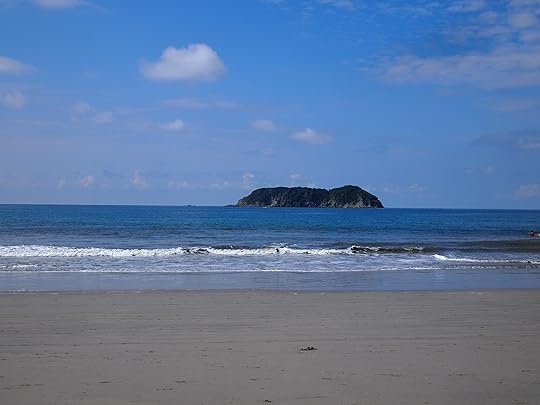
Manuel Antonio beach
After two nights in the dense clouds and chilly winds, we took a three-hour shuttle trip from Monteverde’s 1400 meter high cloud forest to the Pacific beach village of Manuel Antonio. We shucked coats, hats, and pants for bathing suits, sandals, and sunglasses. We were ready to get back to tropical adventures.
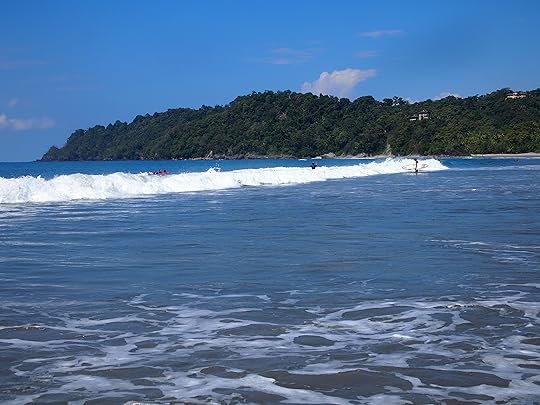
Come on in, the water’s warm!
Our drive to Manuel Antonio took us along the 48,000 km Pan American Highway which starts in Alaska and goes all the way to the southern tip of South America with one break in southern Costa Rica. The PA highway is busy with trucks, buses, vans, and cars heading north and south through Central America. But the highway was quite good, widening to four lanes in areas, and road signs to major destinations on the Pacific coastline and to Costa Rica’s interior. Most roads and streets in Belize and Costa Rica had no signals, street signs, mileage markers, or destination markers making it difficult to know where you were or where you were going. Very confusing.
Puntarenas
The Pacific coastline of Costa Rica includes a peninsula and Puntarenas province that include miles of beautiful beaches. Our last hour, we drove along the coast, often only a few meters away. There was no lack of resorts, hotels, open beaches, and villages. It was quite charming, watching gentle waves coming ashore and green waters of the Pacific Ocean. This is also a prime growing area for date palm trees which produce palm oil for cooking. Every few miles, we’d come to a village with a plant where date palms are processed. There was a distinctive odor emanating from the factories, a smell similar to fermented cabbage.
Verde Mar
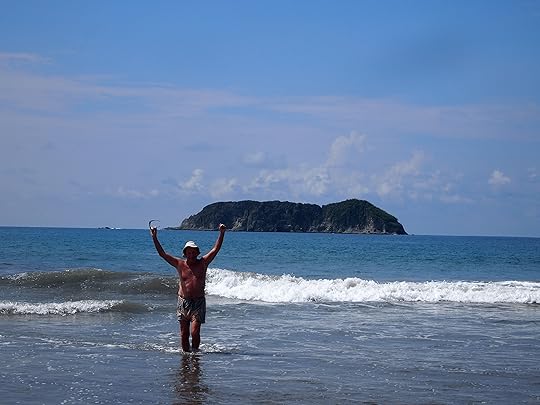
Another day swimming at Manuel Antonio
Our hotel, Verde Mar, was on the beach which we reached by walking through a small gate and over a wooden boardwalk. Ten minutes after we arrived , we were on the beach, digging our toes in hot sand, anxious to dive into the warm Pacific. It was wonderful, a welcome break from the chilly Monteverde weather.

Lucy enjoying morning coffee before she hit the surf
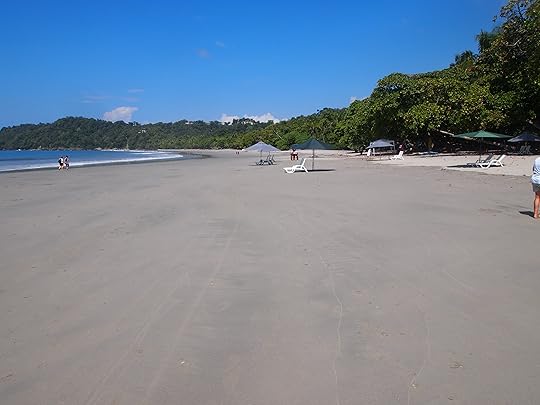
Morning on the beach before everyone gets their beach umbrella
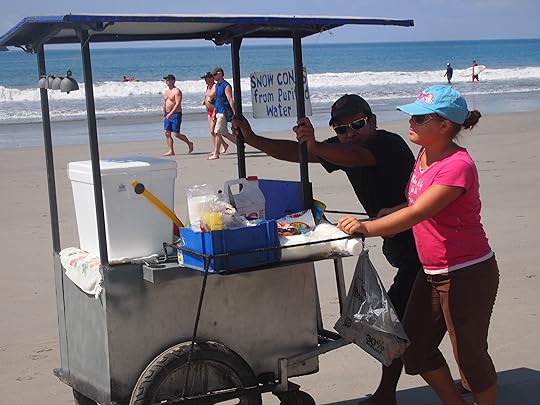
Snow cone vendor on the beach
Village X
We liked the ease of staying at Verde Mar. The hotel had a cafe, and we were only a ten minute walk from a village. We later discovered we could reach the village by walking barefoot along the beach.
The village was a little on the seedy side, open air restaurants, a pizza place, coffee shop, market, and souvenir shops. We walked there every day, sometimes just to see what was happening and watch what vendors were hawking. The entrance to Manuel Antonio National Park was in the village, but we didn’t enter. We’d visited several national parks already in Costa Rica and preferred to spend time on the beach and having other adventures. We never did learn the name of the village.
One evening we walked back on the sidewalk — the beach was too dark with no moonlight — and saw a couple ahead who were stopped, aiming cell phone cameras into a tree. But it was dark — what could they be looking at? We approached and looked up in the trees. We were surprised to see a sleeping sloth hanging on a cable. He was upside down, hands and feet clutching the cable, immobile. Not a muscle moved for five minutes or so as we gazed up at him. It was touching, seeing a sleeping sloth only a couple of meters above us.
Pacific sunsets
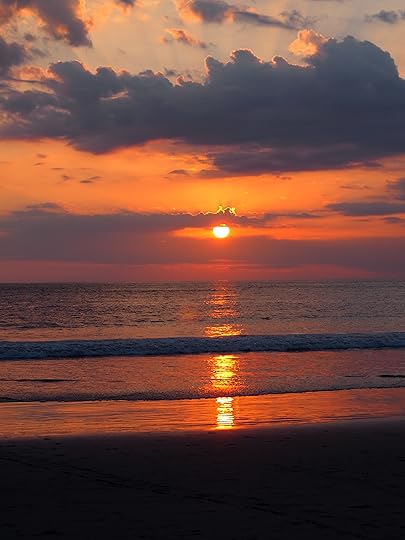
Sunset at Manuel Antonio
Sunsets were amazing along the beach. We strolled out most evenings to admire the spectacle of the glowing sun dipping below the horizon in a blaze of purple, orange, and crimson. This became our favorite stroll as we headed along the beach to Village X for dinner and a walkabout.
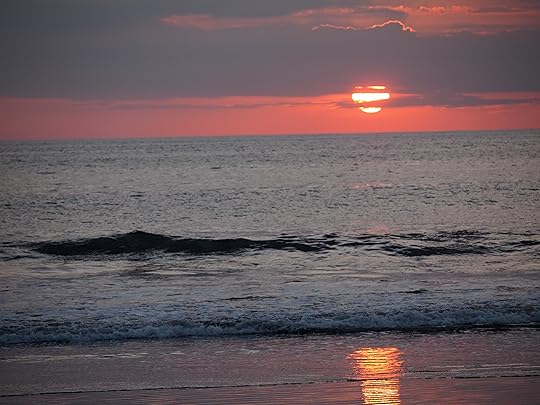
Just another Costa Rica sunset

Last night at Manuel Antonio, missed a glorious sunset
We spent many afternoons on the beach, but didn’t have our camera with us — dashing out to swim, hot sun beating down, leaving our things under the umbrella — too busy to play photographer. But we took many photos during our time in Manuel Antonio, but too few of the beach unfortunately.
Follow us and see what else we did during our five nights in Manuel Antonio!
* * * * *
Welcome to our Central American travel adventure. Share a comment with us, we want to hear from you!
Next: Catamaran sailing in the Pacific


